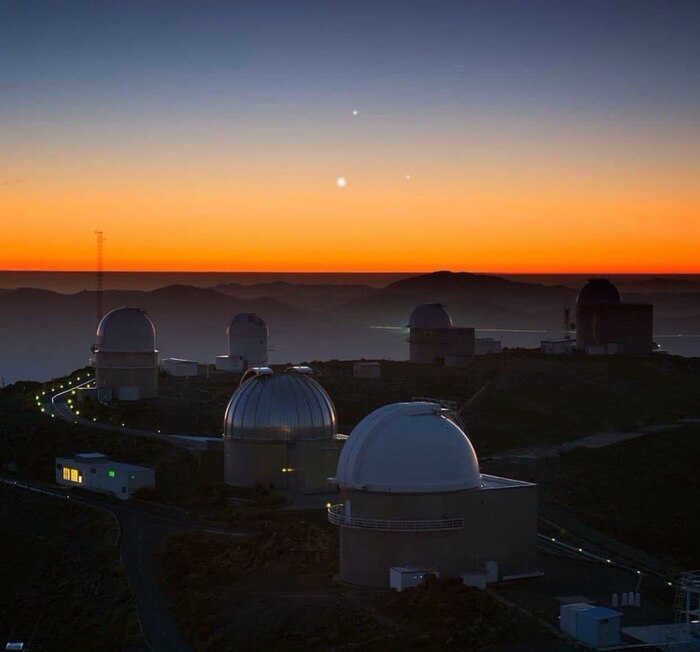
This photo, captured at ESO La Silla Observatory in Chile, showcases the rare alignment of Jupiter (at the top), Venus (at the bottom left), and Mercury (at the bottom right). The occurrence of these three planets appearing so closely together is a rare phenomenon that only happens once every few years.

Planets resembling Jupiter
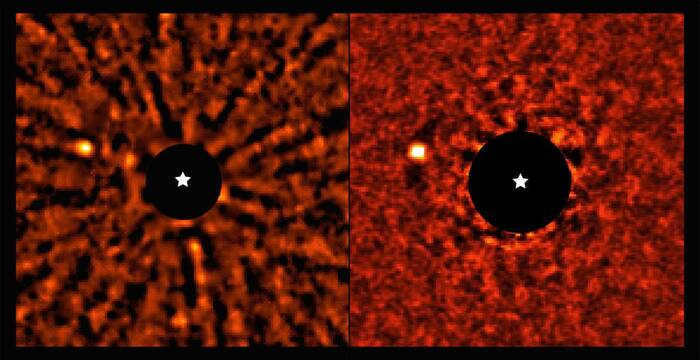
Several teams of scientists have used the SPHERE detector on the VLT telescope in Chile to capture two images of a planet similar to Jupiter near the star AF Leporis.

Images of Jupiter and its largest moons captured with an 8-inch telescope
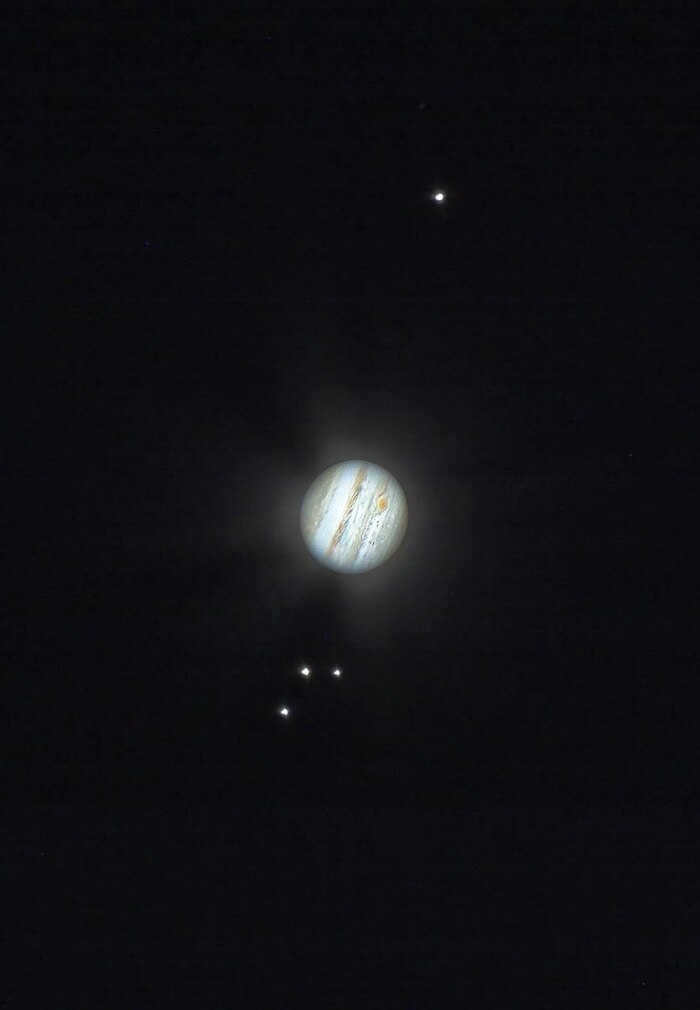
Did you swim, enjoy some juicy watermelon, or sit around a cozy campfire? How did you spend your summer?
Even if your summer consisted mostly of work, don’t be disheartened. We have an exciting activity to keep you entertained throughout the season! Gather a collection of summer mementos and earn yourself a featured profile on Peekaboo. Additionally, you’ll discover how to make summer vibes last all year round.

The finest pictures of the James Webb Space Telescope JWST
This photo showcases the Pillars of Creation, a celestial area in the Eagle Nebula where new stars are being formed. Gigantic strands of dust from interstellar space can be observed stretching out into the vastness of the universe. At the tips of some of these pillars, one can spot reddish stars, whose hue has been altered by the dust that still enshrouds them. The bluish stars nestled within the clouds are the ones that have managed to disperse much of the surrounding dust. The subject of this photograph is located 2,000 parsecs away from Earth in the constellation of the Serpent.
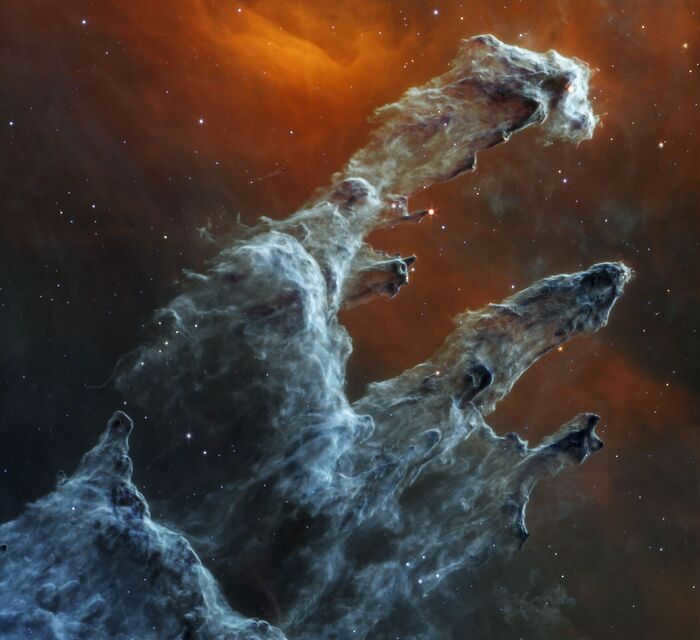
One of the most striking sights unveiled in the initial unveiling of the telescope’s photographs in July was this brilliant panorama within the Kiel Nebula, located approximately 2,300 parsecs (7,600 light-years) away from our home planet. The vibrant orange formations consist of colossal gases and particles, which have been shaped by the ionizing radiation emitted by the celestial bodies positioned above them. The James Webb Space Telescope (JWST) has captured intricate three-dimensional features, such as pillars and jets, nestled deep within the hazy masses where nascent stars are born. Furthermore, this remarkable telescope has managed to penetrate the dense clusters to discern individual stars and galaxies residing beyond them.
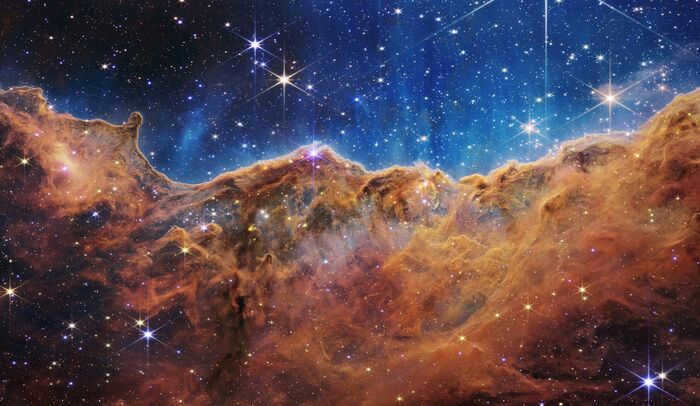
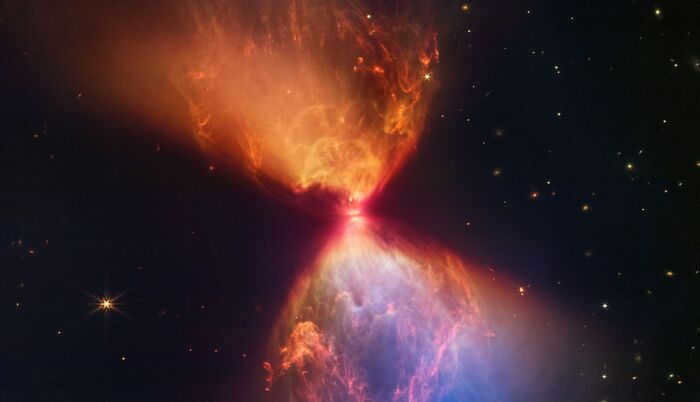
The ice giant Neptune has a surreal look as it glides alongside its extraordinary partner Triton (the shining object in the upper left). Neptune is surrounded by several thin, luminous rings, and there are glowing dust lanes near the planet. By using the telescope’s infrared image, we were able to observe features like the brightness near the north pole of the planet and the clouds encircling its south polar vortex. Additionally, there are six other moons visible near Neptune and its rings.
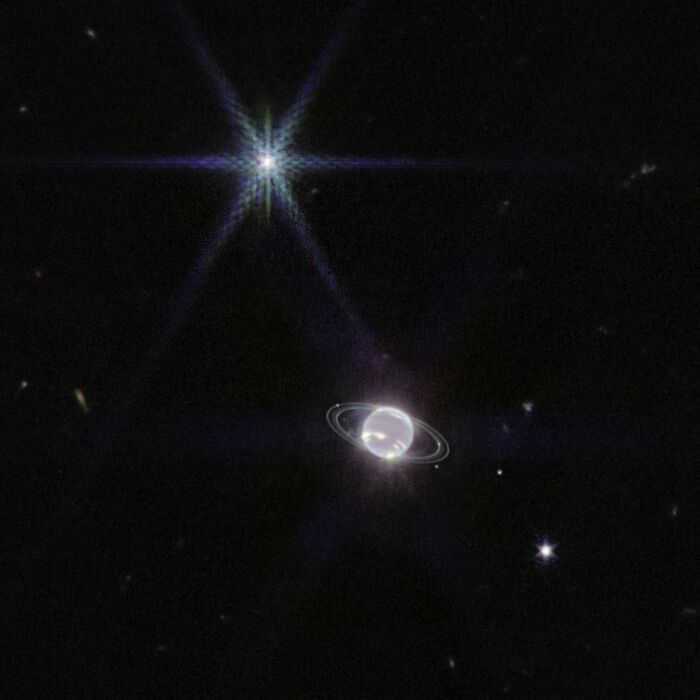
Another space telescope takes over the baton as it reveals the star-filled center of the Phantom Galaxy. The Hubble Space Telescope (Figure 1) captured a breathtaking view of the galaxy, showcasing its classic spiral arms that extend outward from its core. However, when the JWST took an infrared image of the same galaxy, a new level of detail emerged. The image revealed the intricate gas and dust formations within the spiral structure, with a mesmerizing blue glow emanating from the star cluster at the galaxy’s center. Located in the Pisces constellation, this galaxy is situated approximately 10 million parsecs away.
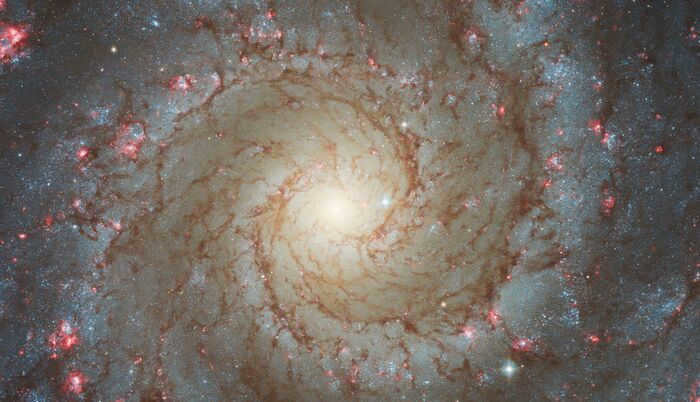
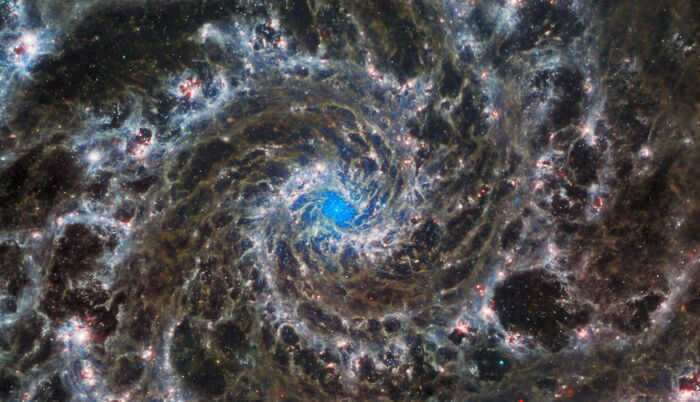
Spokes that resemble a wheel stretch from a radiant inner circle to a vibrant outer circle in the Cartwheel Galaxy, located approximately 153 million parsecs away in the constellation Sculptor. This peculiar and luminous formation took shape as a result of a collision between a small galaxy and a large spiral galaxy, causing a distortion in its structure. The infrared capabilities of the JWST enabled it to penetrate through the typically obstructive dust, revealing intricate details. Young stars are apparent as blue dots, particularly along the spokes and outer ring. The red areas indicate regions rich in hydrocarbons and other compounds. Additionally, the image includes X-ray data captured by NASA’s Chandra X-ray Observatory, predominantly displayed in purple, showcasing superheated gas and other high-energy phenomena. Situated on the left are two smaller companion galaxies.
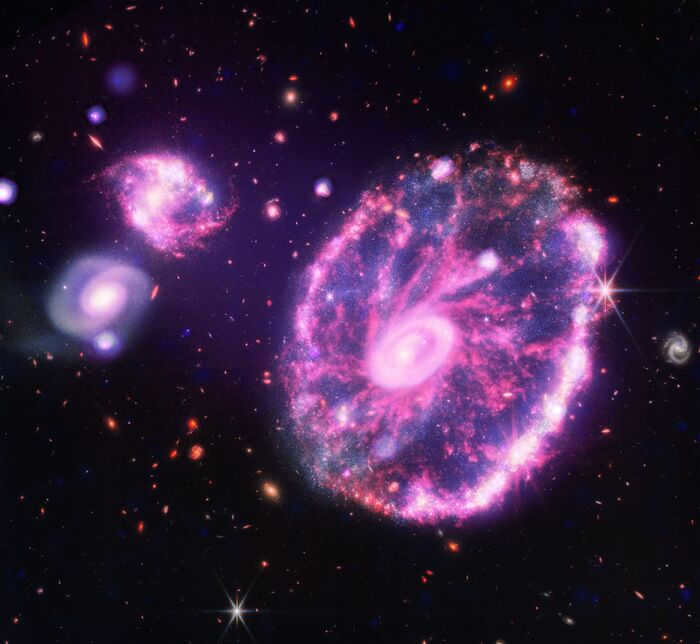
The Tarantula Nebula is a stunning sight, with newborn stars shining like blue fireworks amidst a cloud of orange-white dust. This nebula, located in our galactic neighborhood, is known for being the largest and brightest region where stars are born. Within the dusty cocoon, the powerful stellar winds from young stars have created clear pockets, giving the nebula its unique appearance. In the upper left corner of the center, there is an older star that emits bursts of brightness, although this is actually just an observational artifact. This captivating image captures an area that spans approximately 110 parsecs.
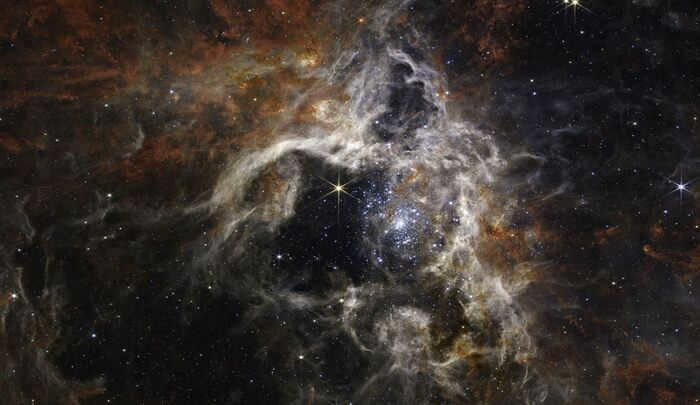
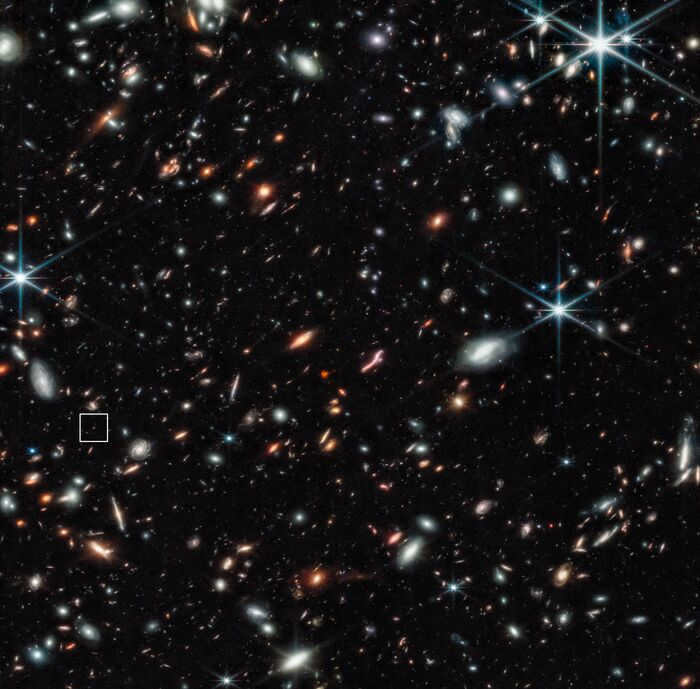
There are at least 17 rings of dust encircling a colossal binary star named WR 140, which is situated approximately 1,800 parsecs away in the Swan constellation. Within this stellar system, the two immense stars revolve around one another, drawing nearer every eight years. With each close encounter, the system expels a fresh batch of dust into outer space, resulting in the formation of concentric rings that gradually expand, akin to the annual rings found within a tree.
Save this for later
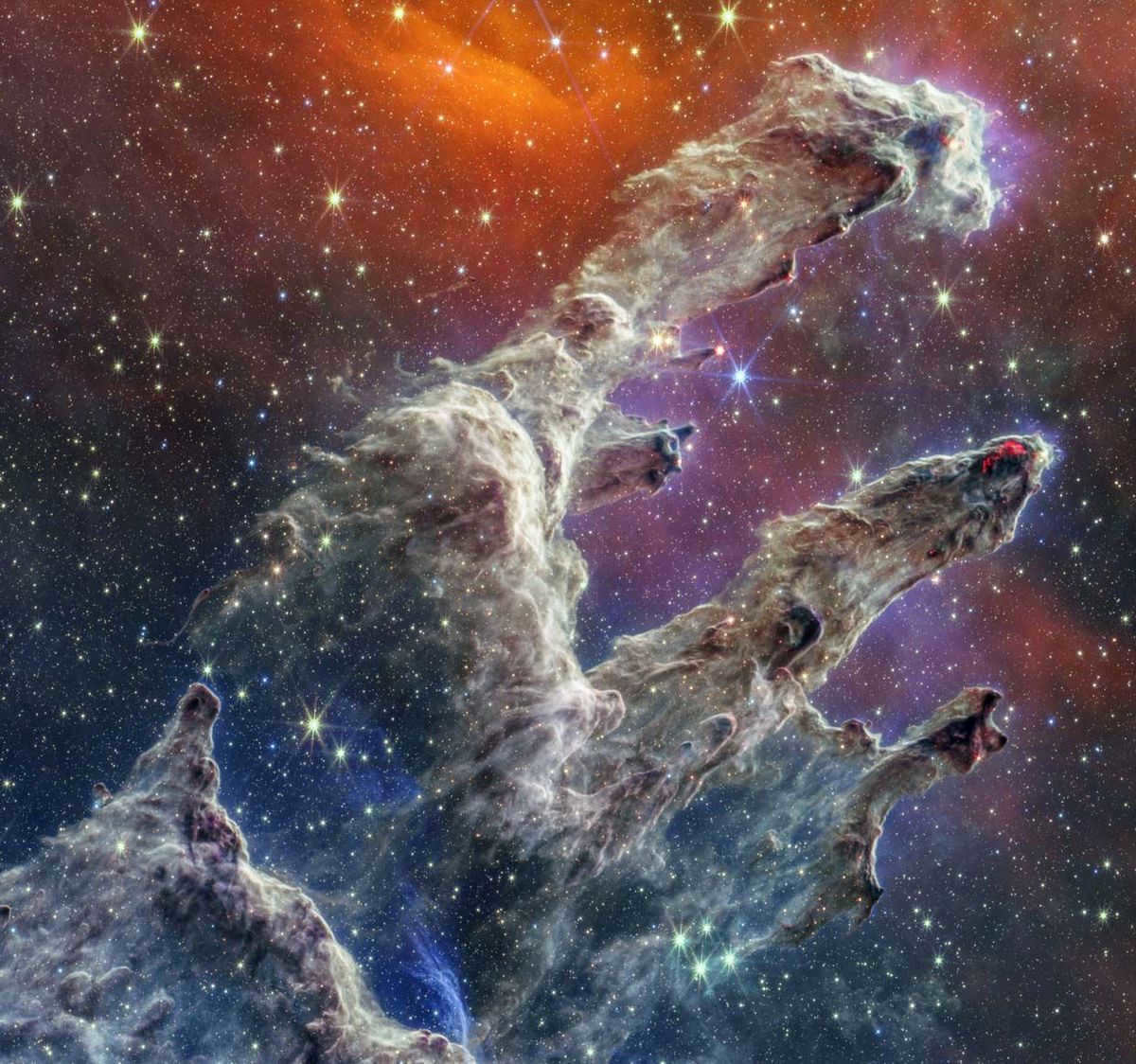
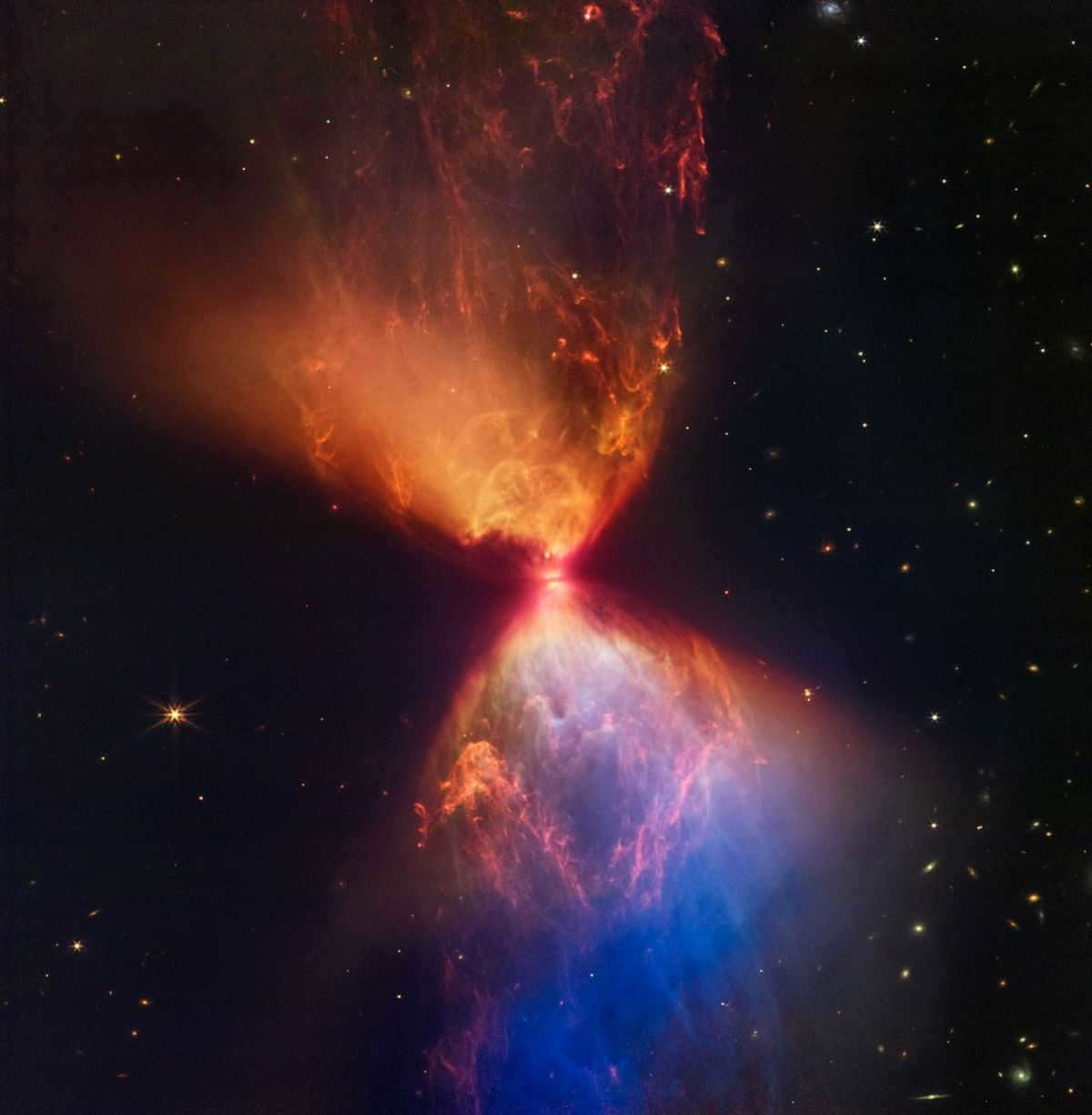
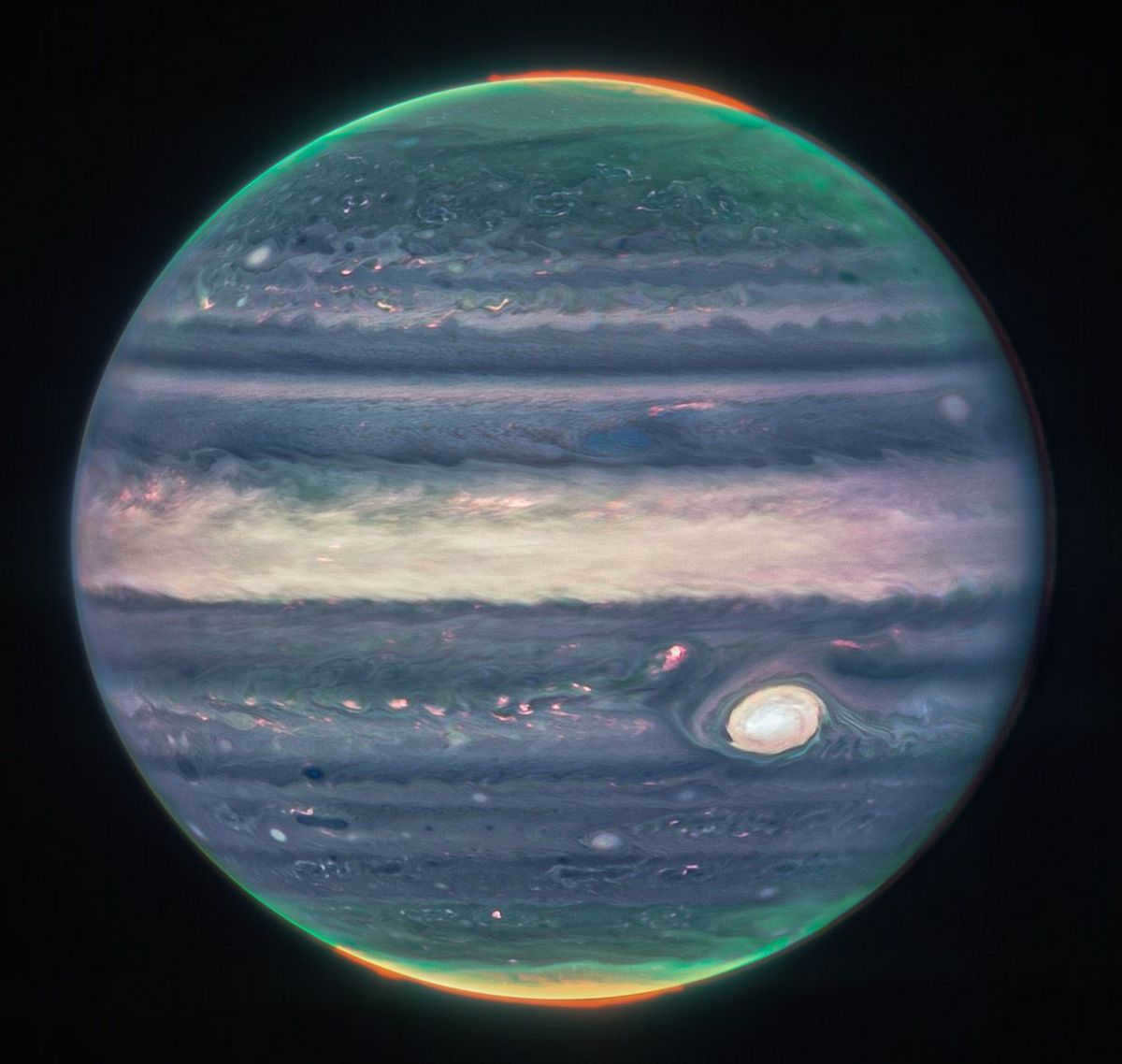
Space is not actually black. Its appearance as black to us is due to the limitations of our eyes and most sensors, which are not equipped to detect the various forms of radiation emitted by the countless objects in our vast Universe.
This is precisely why the Orbiting Observatory, known as James Webb, was launched in December 2021.
With its advanced capabilities, the James Webb Observatory captures high-resolution images of celestial objects, both nearby and hundreds of millions of light-years away, using near and mid-infrared technology. This enables us to perceive and study phenomena that were previously beyond our visual perception, thanks to the remarkable strides in technology.
The observatory has been under development for two decades and has been a joint effort between NASA, ESA, and CSA. The project has consumed over $10 billion in funding. Currently, the spacecraft is situated 1.5 million kilometers away from Earth, which is equivalent to five times the distance between Earth and the Moon. Its imaging capabilities surpass those of the Hubble telescope by a factor of 5.6 and are up to 10 times superior to its Earth-bound counterparts.
During its first year in space, the observatory has made numerous groundbreaking discoveries. We have compiled a collection of the most awe-inspiring photographs, along with their respective narratives.
Take a look at the remarkable results.
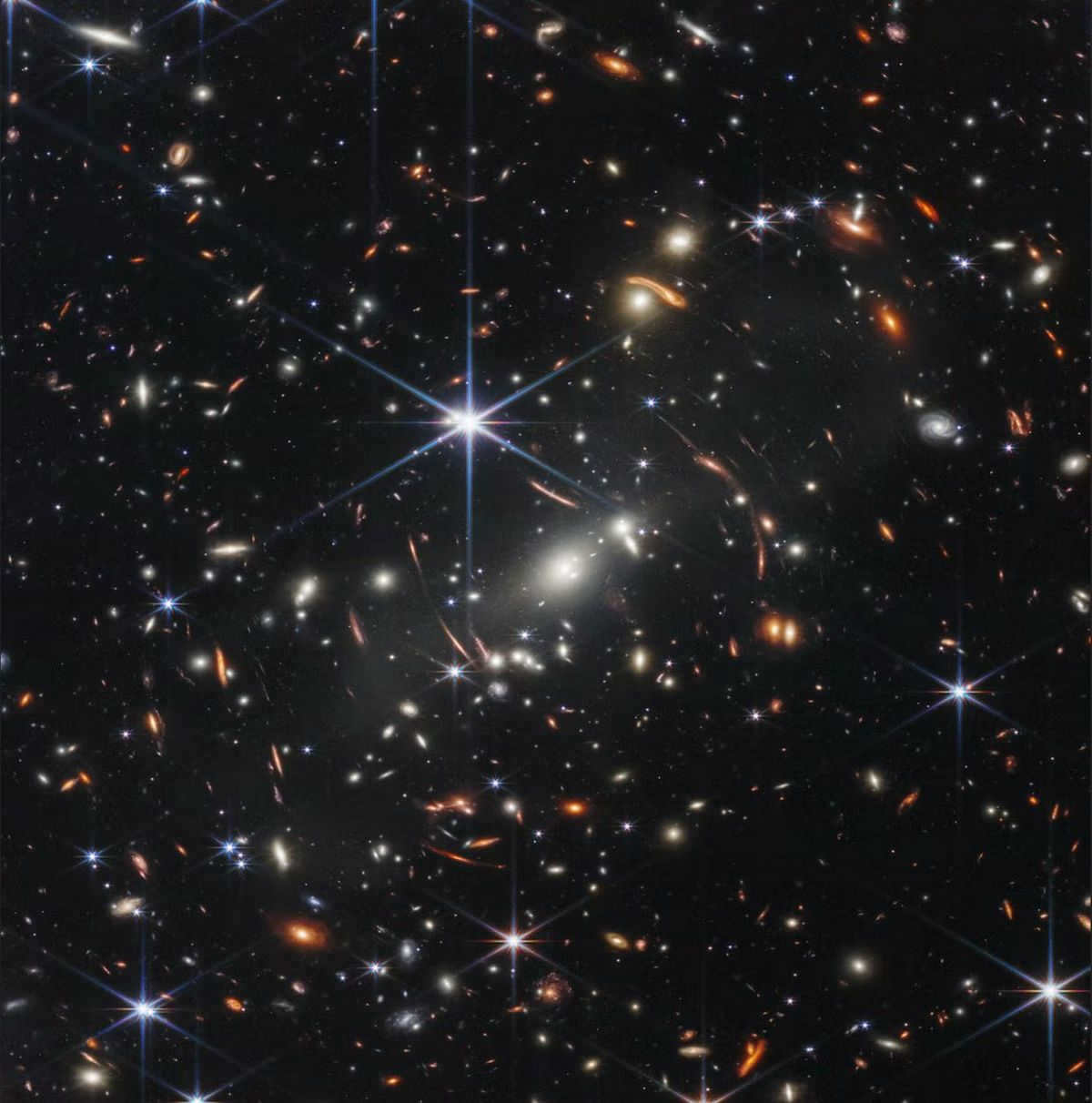
Here available in its entirety
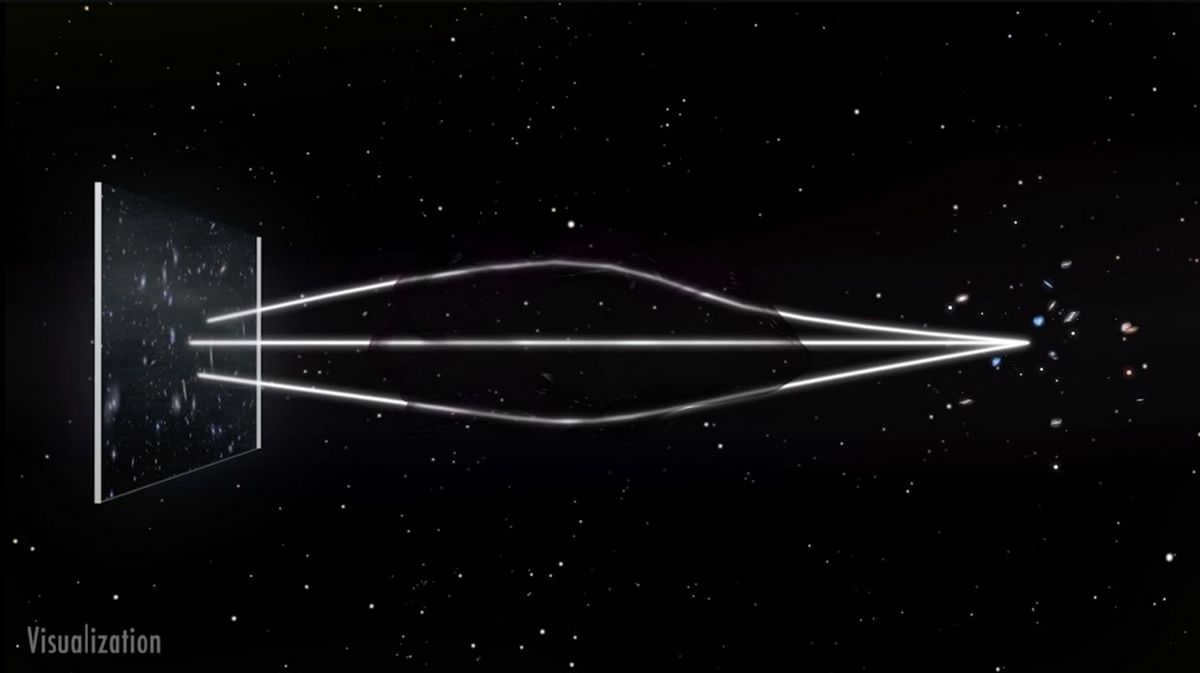
The gravitational distortion of galaxies, rather than telescope issues, creates the lensing effect.
The majority of the bright spots visible above are galaxies.
This particular section of space is situated so far away that in the night sky, it would be obstructed by a grain of sand held at arm’s length. From this vantage point, one can observe the lensing effect, which is not caused by the optics of the telescope, but rather by the gravitational distortion from other galaxies near the captured segment of the universe in the photograph (the involvement of dark matter is a separate topic).
These distortions have resulted in the appearance of two galaxies near the center, even though they are actually the same galaxy. This was proven through spectral analysis using the same telescope.
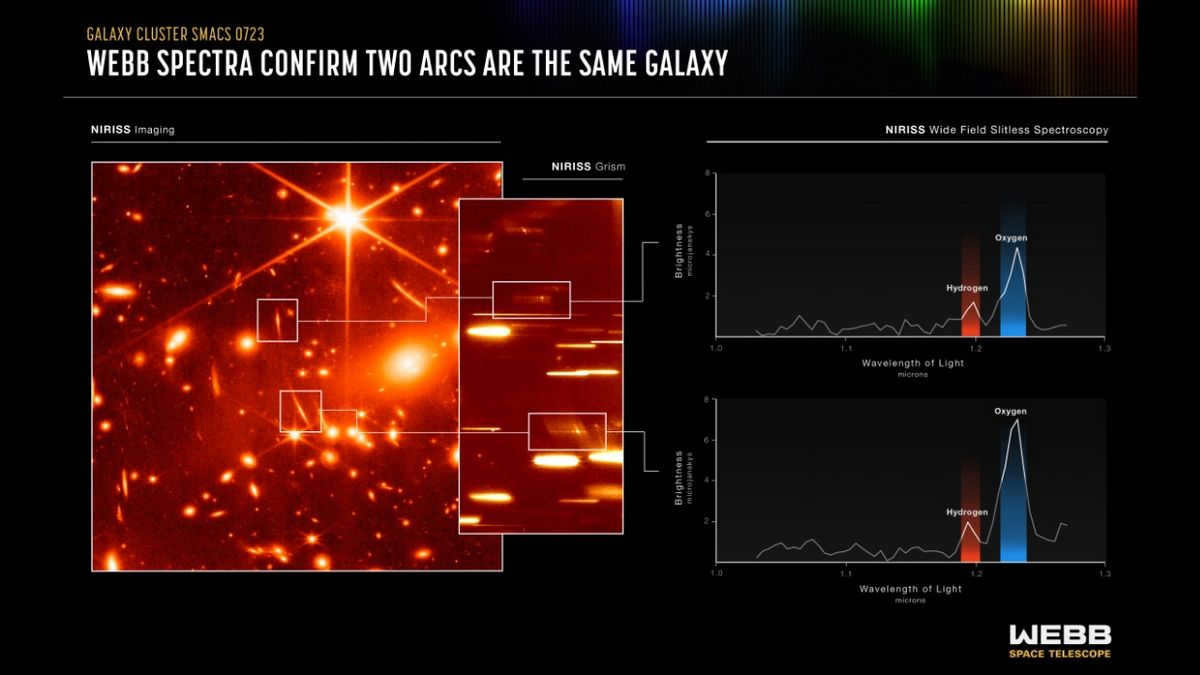
A celestial formation that appears as a pair of galaxies
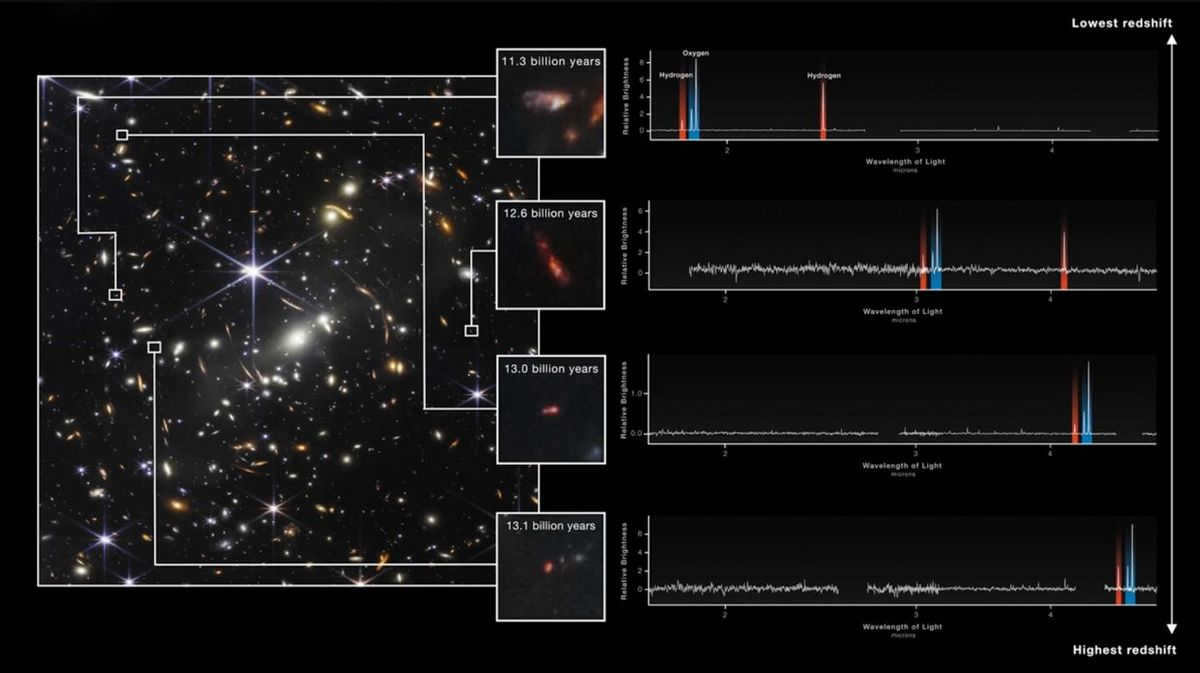
The oldest galaxies from the earliest times are depicted as red dots in this image. The reason for their red color is
It is also worth noting that one of the galaxies in this photo is 13.1 billion years old. To put it in perspective, this galaxy is so ancient that it appears to be in its infancy in the frame. Keep in mind that our Universe is currently believed to be 13.8 billion years old. Therefore, one of the oldest galaxies appears as a newborn to us, considering the time it took for its light to reach us.
This image was created by combining photos taken at different radiation levels. The entire process took 12.5 hours, while the Hubble telescope spent weeks capturing a much less detailed version of the same region of space.
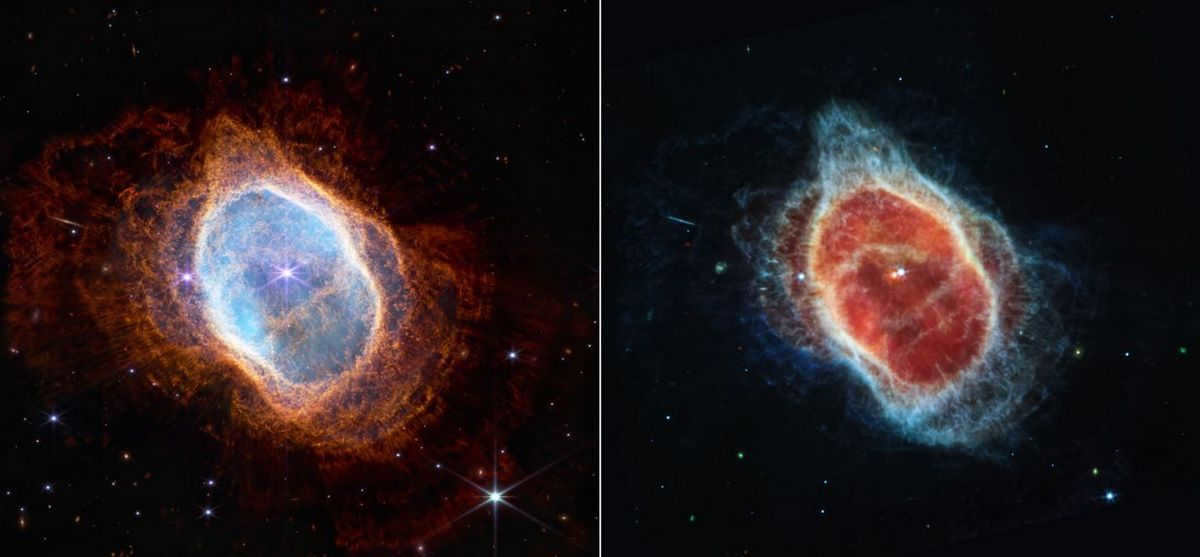
On the left is the original near-infrared photo, while on the right is the original mid-infrared photo.
This serves as a stunning example of how nebulae are formed.
The southern ring nebula is composed of two stars, its beauty being created by a white dwarf. Over the course of several thousand years, it has been emitting ionized gas and ultraviolet radiation, resulting in the object’s striking ring coloration.
Previously, the Hubble telescope captured an image of this phenomenon. However, this new version enables a more thorough examination of the material’s composition and the positioning of gas molecules within the flare.
The younger star, which is brighter, influences the gravitational distribution of the “clouds”. In reality, the nebula does not resemble a ring, but rather two soup bowls placed with their bottoms facing each other, with a void in the center for the two neighboring stars.
3. Pieces of Space
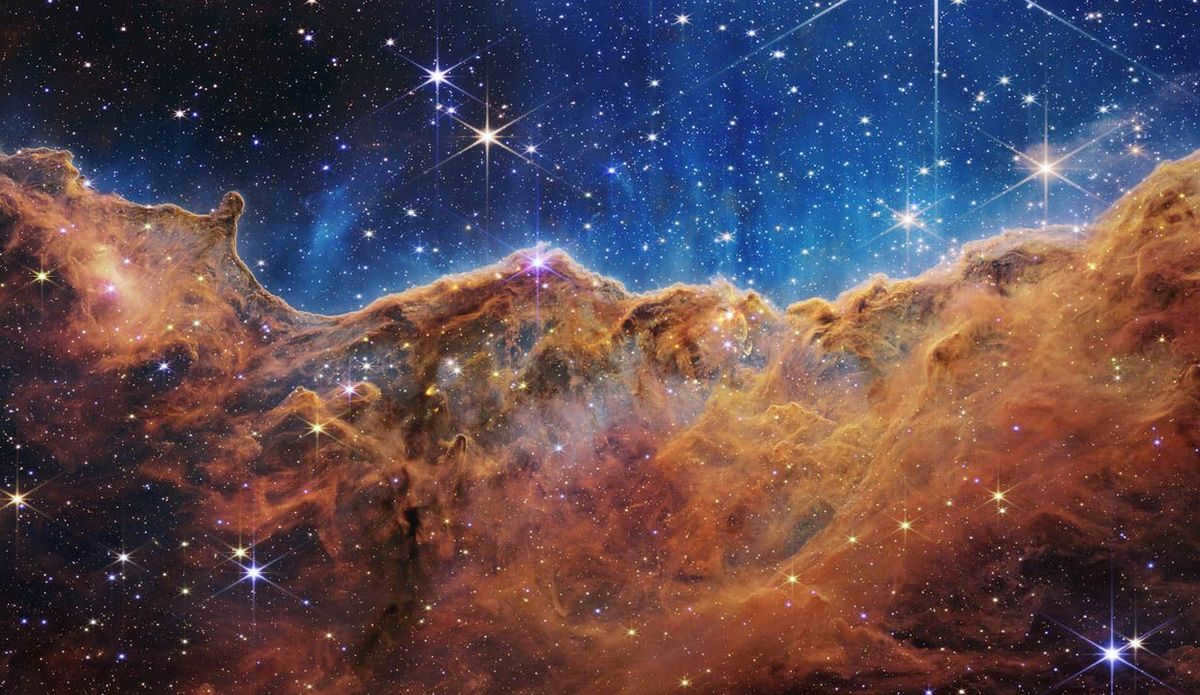
Here are the high-resolution versions
Located a mere 7500 light-years from our planet, lies a stellar cluster known as the Kiel Nebula. While you may have previously witnessed the awe-inspiring outer wall of this magnificent celestial body, the Webb telescope has granted us the ability to delve deep within and meticulously study the composition of this colossal formation.
The massive “mountains” within the nebula span an impressive distance of 7 light-years and consist of dense gas and dust, which serve as the building blocks for the creation of new stars.
Radiation emitted by the stars in the vicinity of this image causes the dust and gas to be expelled, resulting in the creation of a cavernous region resembling the Earth’s colors. The blue “vapor” represents the gas that remains superheated by the ultraviolet radiation, which was unable to escape the “explosion” and is now evaporating.
This new photograph provides a greater sense of the nebula’s volume and texture, unveiling numerous previously imperceptible stars.
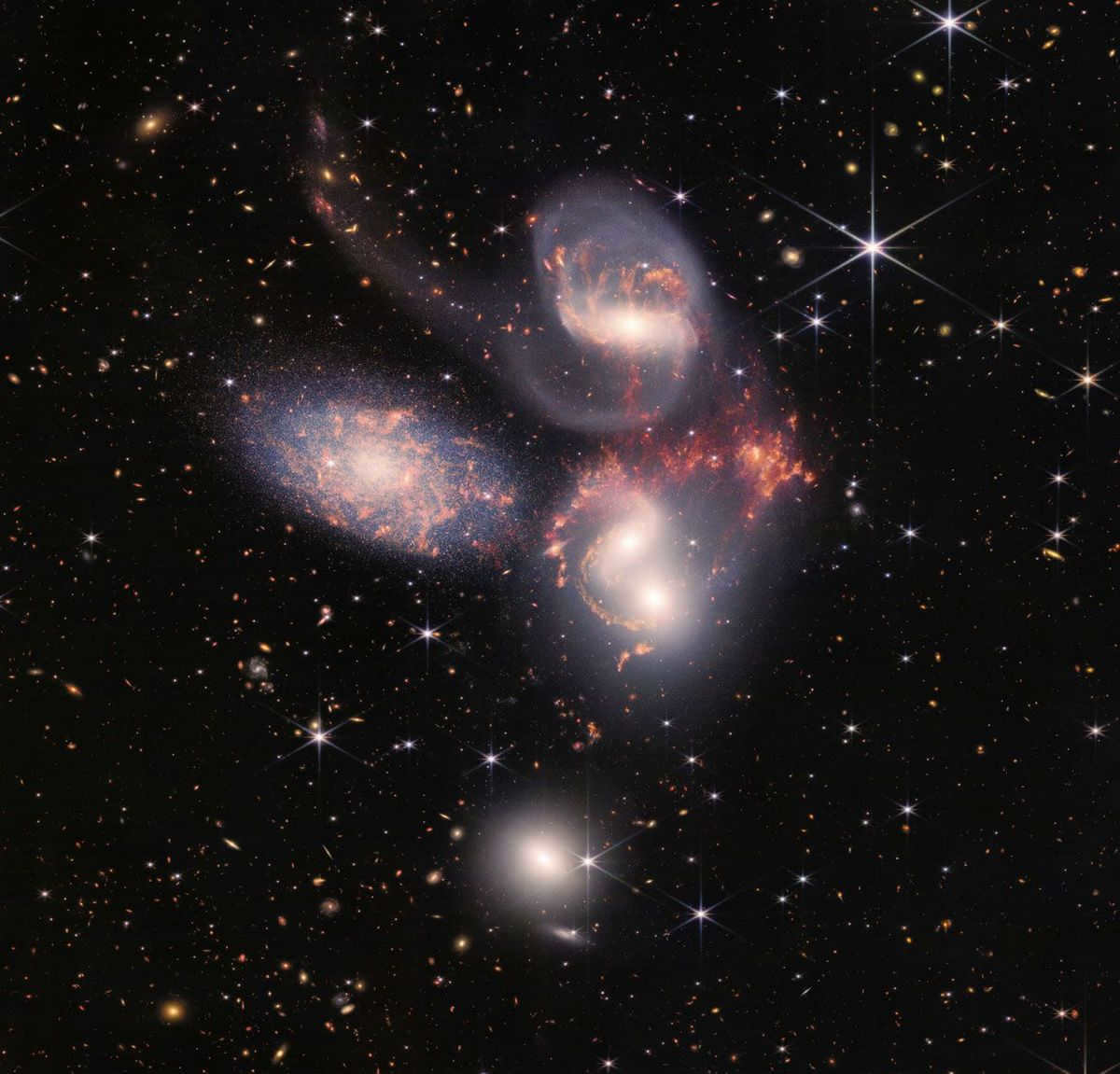
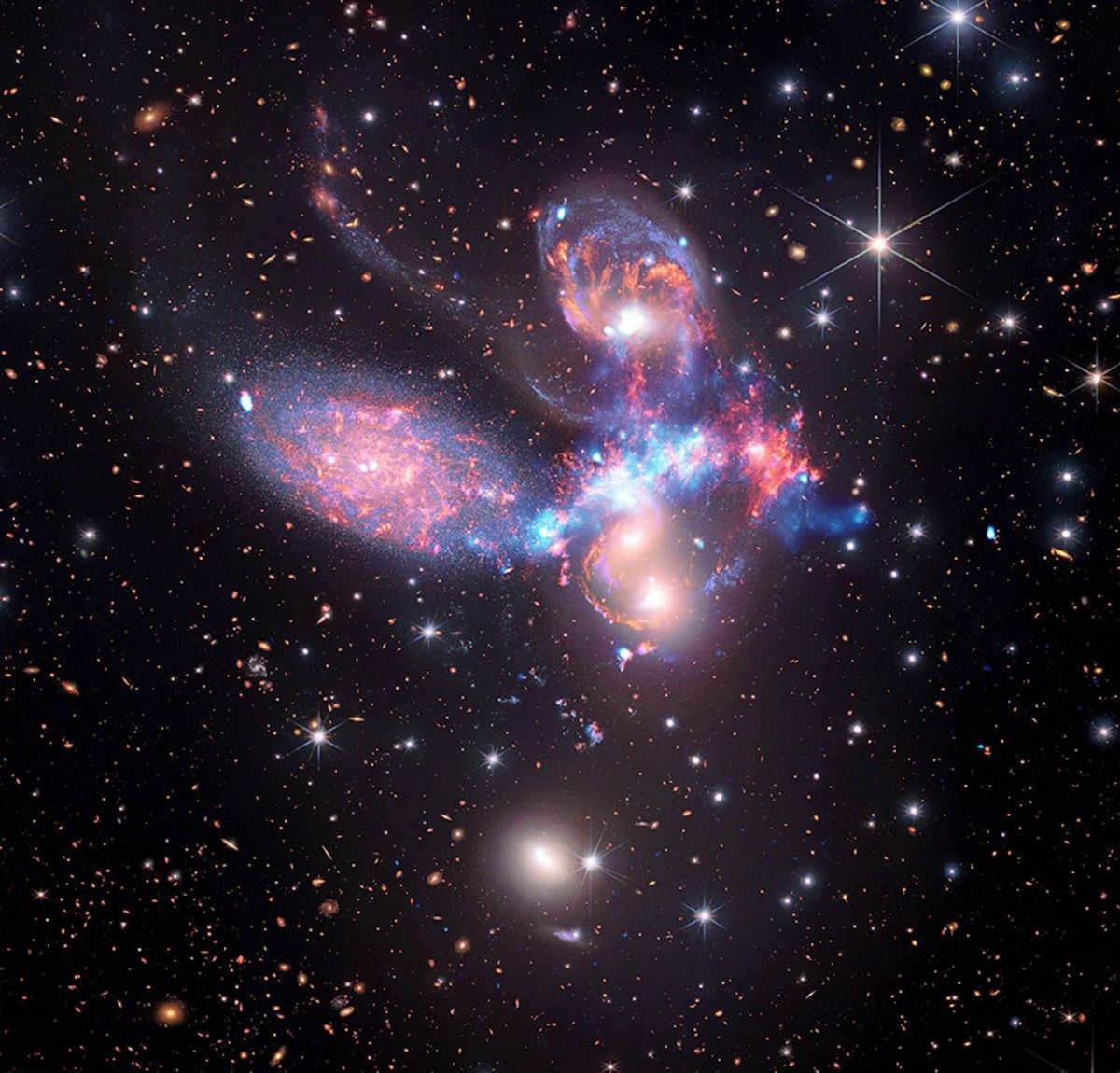
The illustration depicts the manner in which the merging galaxies within a cluster known as the Stephan Quintet induce the initiation of star formation in one another and how the distribution of gas occurs between them. During the early stages of the Universe, this phenomenon was quite common due to the close proximity of these clusters.
The Webb telescope provides an unprecedented level of detail regarding the ongoing processes. For instance, it offers a clearer view of the emissions from a black hole (quasar) located at the center of the topmost galaxy. Through the utilization of infrared sensors, it is now possible to discern the various types of gases that form at the periphery of its event horizon, which was previously unattainable.
The galaxy on the left is situated at a greater distance from the rest and is not engaged in any active collision, while the upper galaxy is hurtling towards the other three with tremendous velocity. This event is of such magnitude that Webb managed to capture even the shockwave (the orange band in the center of the photograph) resulting from this intergalactic impact.
5. The emergence of a star

Here are the high-resolution images
Curious to witness the appearance of our Sun 4.5 billion years ago when it was still in its infancy? It resembled the photograph above.
Proto-star L1527 is merely 100,000 years old, not yet fully formed. Homo Sapiens had already inhabited the Earth while its gas was just starting to accumulate.
The star itself, or rather its “seed,” is not visible, as it is concealed behind a dark line in the center of the reaction. This separator is composed of dust and gas, which will eventually evolve into exoplanets like Earth and Mars in the very distant future (around 2 billion years).
One of the main objectives of the observatory is to comprehend the process of gas accumulation and star formation, as well as the reasons why it may not occur. The launch of the Webb telescope was partially motivated by the desire to make such observations and discoveries.
6. The Splendor of a Dwarf Galaxy
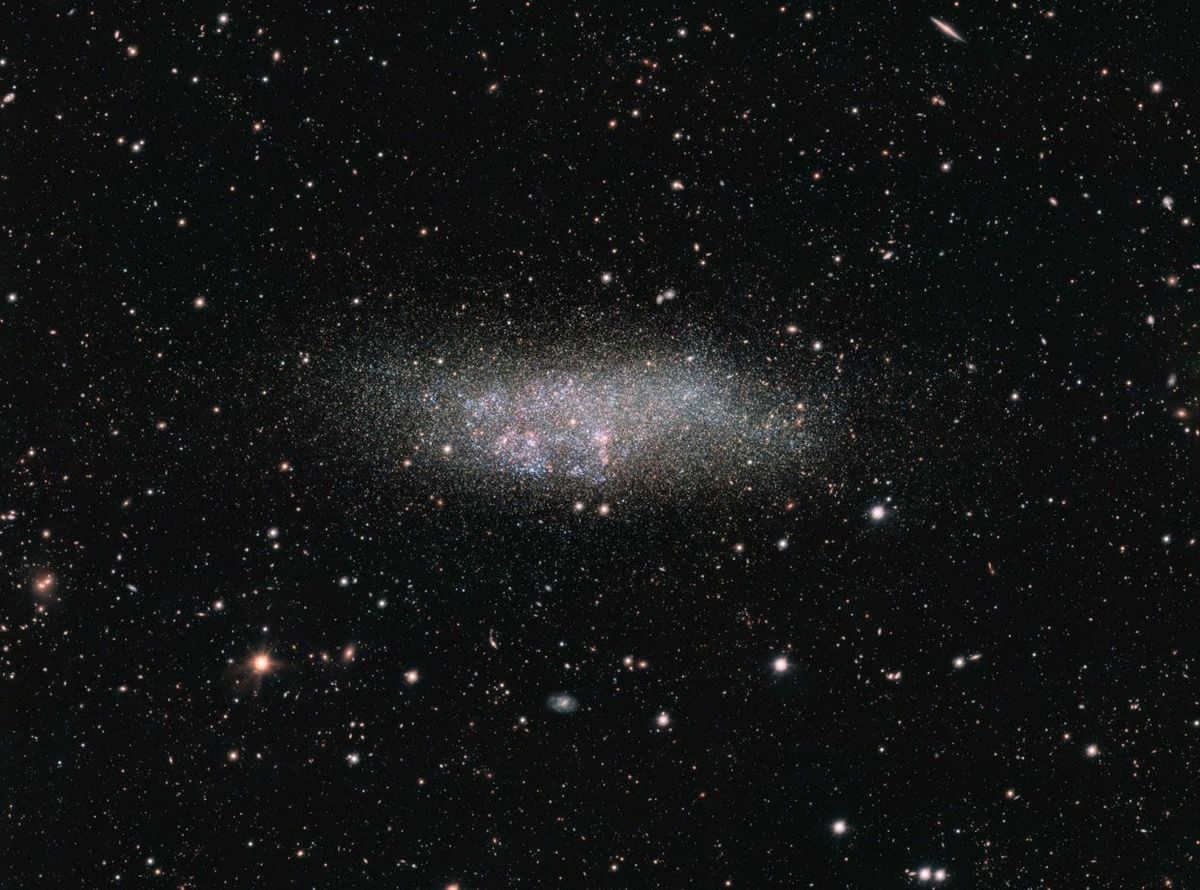
Behold the magnificent Wolf-Landmark-Melott Galaxy captured by the Hubble Telescope.
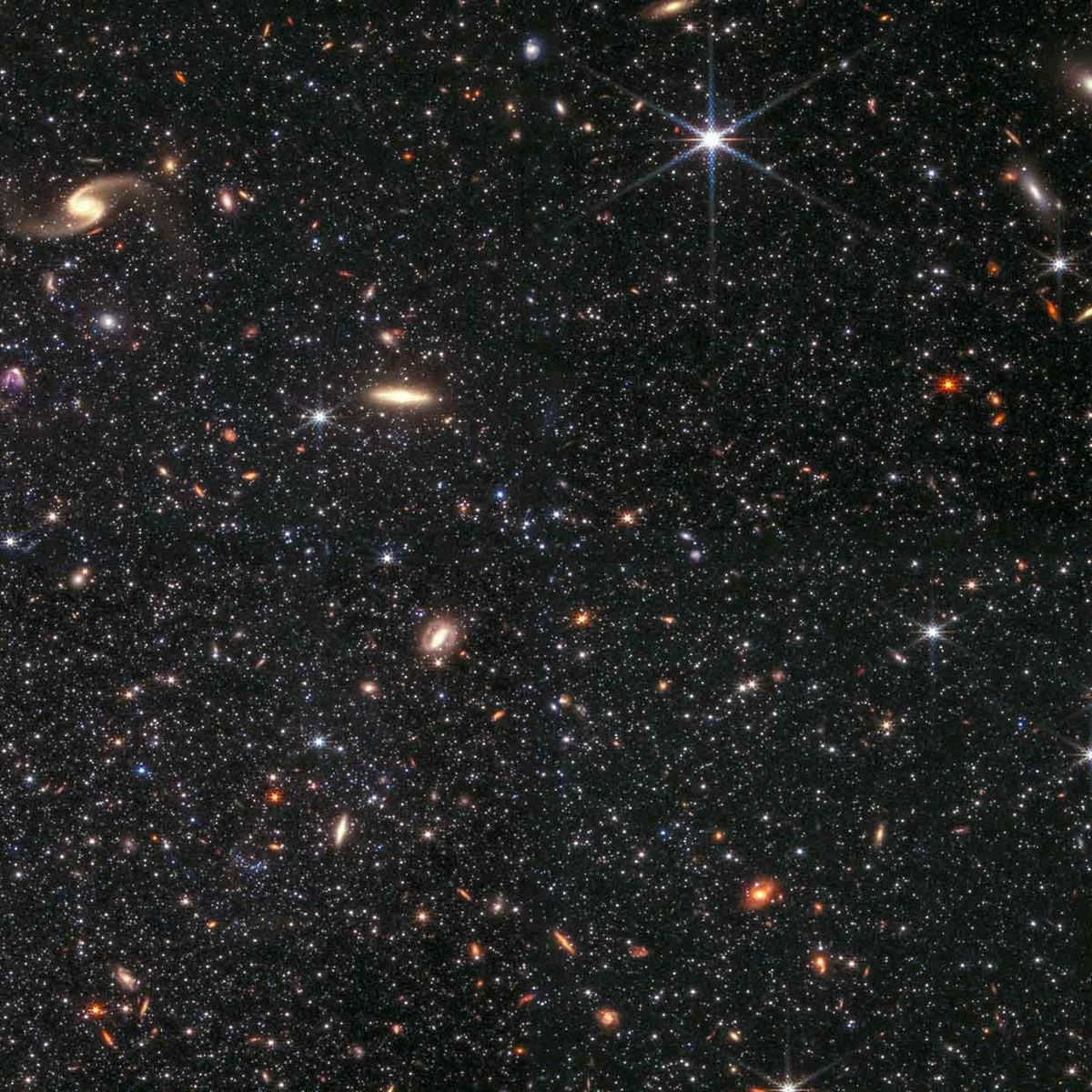
A high-resolution picture of its right flank. You can find the full-size versions below
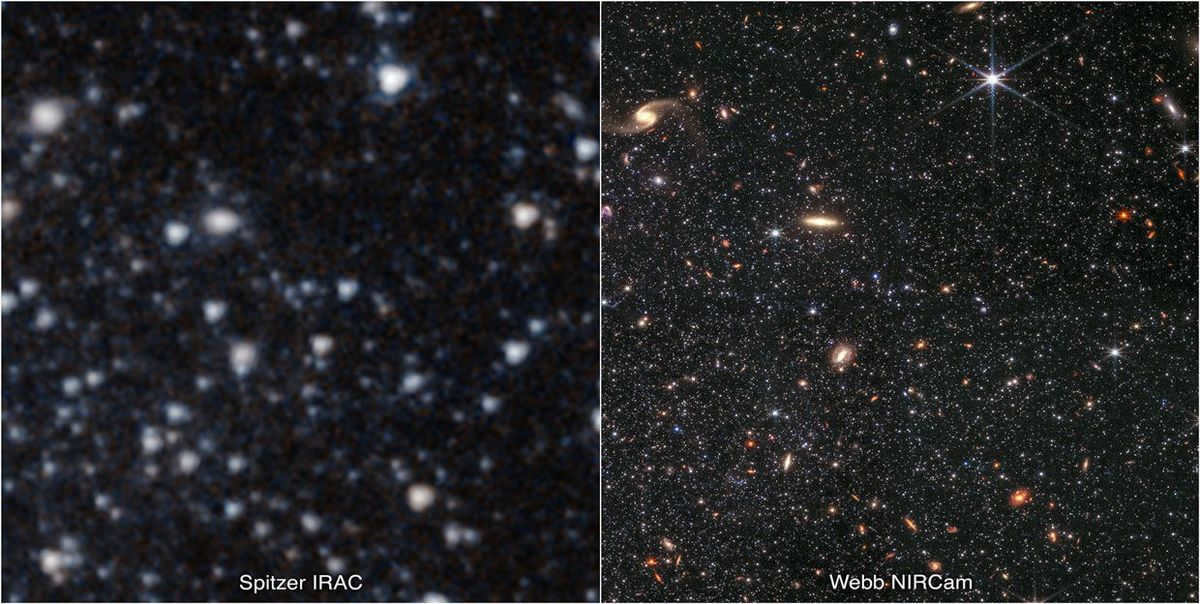
Comparison with a previous photo
Not all galaxies have a black hole at their center, like the Milky Way. For instance, there is simply a collection of star systems without a distinct shape and center, also known as “irregular.”
For instance, Wolf-Landmark-Melott. three million light years away from Earth. It is relatively isolated from other galaxies, which makes the cluster an excellent testing ground for studying the formation and evolution of galaxies.
Using the assistance of James Webb, one of its regions was photographed in such detail that no neural network could display the missing elements.
Low-mass stars can exist for billions of years. For example, our Sun is already 4.5 billion years old, and the projection for its lifespan in different stages is at least another 5 billion years.
Thus, studying the luminaries in an almost pristine galaxy like Wolf-Landmark-Melott provides valuable insights into the early stages of the universe’s formation 14 billion years ago.
7. Shedding new light on Neptune’s rings
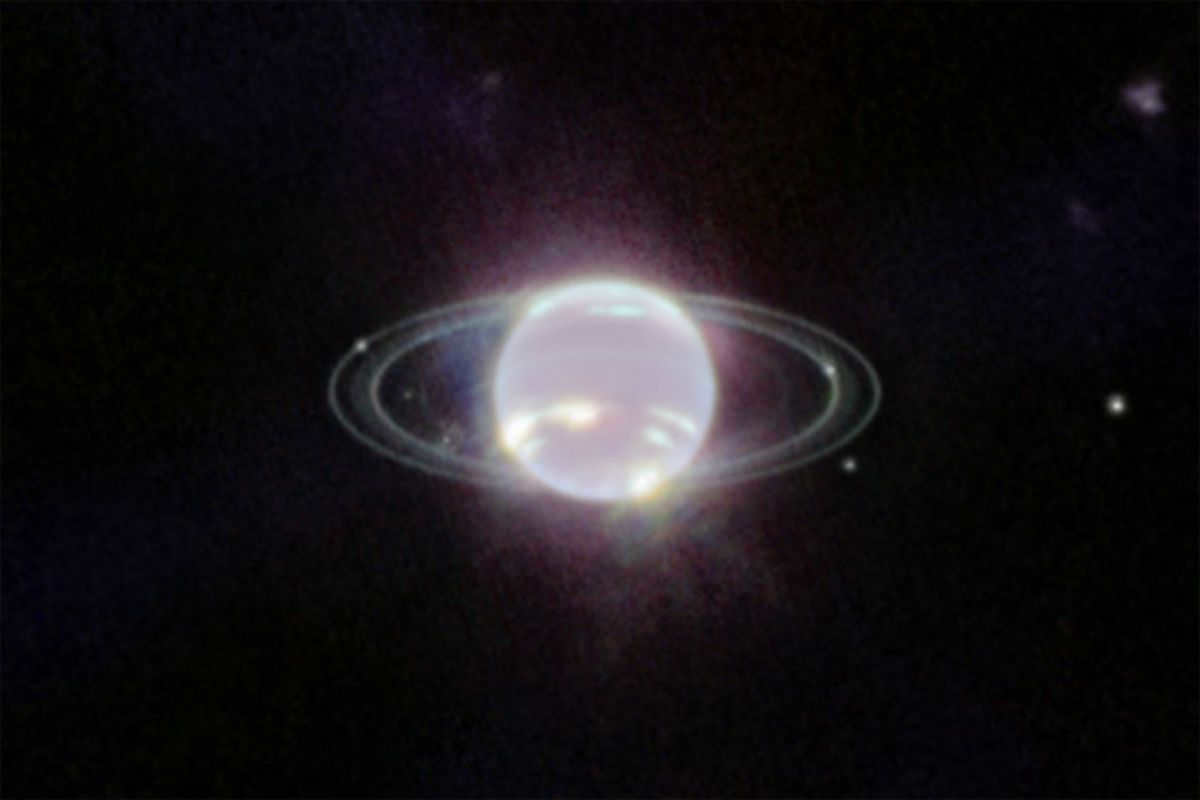
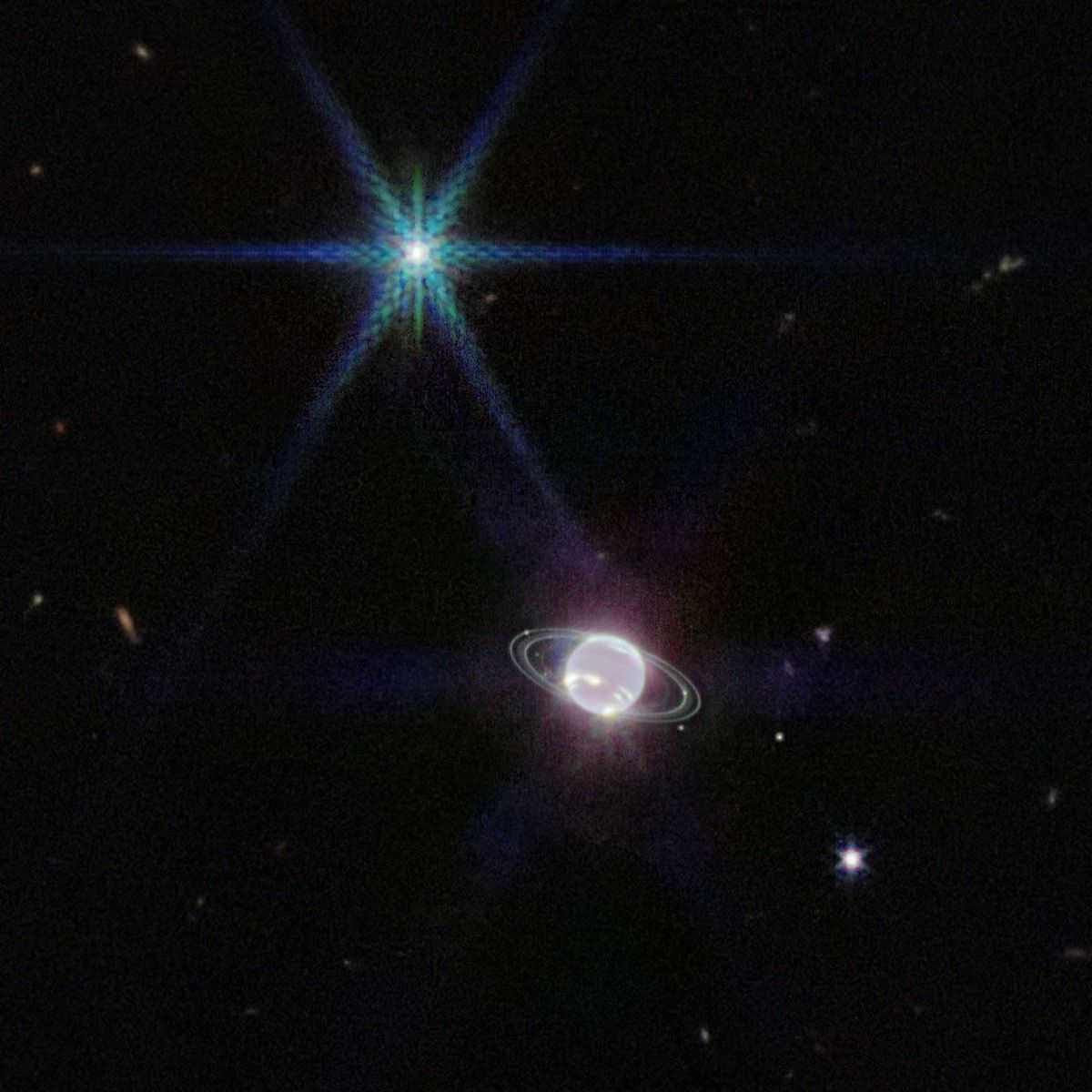
Since 1989, no spacecraft has explored Neptune after Voyager 2’s tangential flyby.
The ethereal image captures Neptune’s rings, its turbulent and windy atmosphere depicted as white clusters, as well as six out of its fourteen moons, with one of them shining the brightest in the upper left corner, Triton.
The peculiar glow is a result of the methane ice on the planet’s surface absorbing a significant amount of the telescope’s infrared radiation. As a result, the central part of the planet appears dark, while a bright halo – the light reflected from Neptune’s methane atmosphere – is visible around its perimeter.
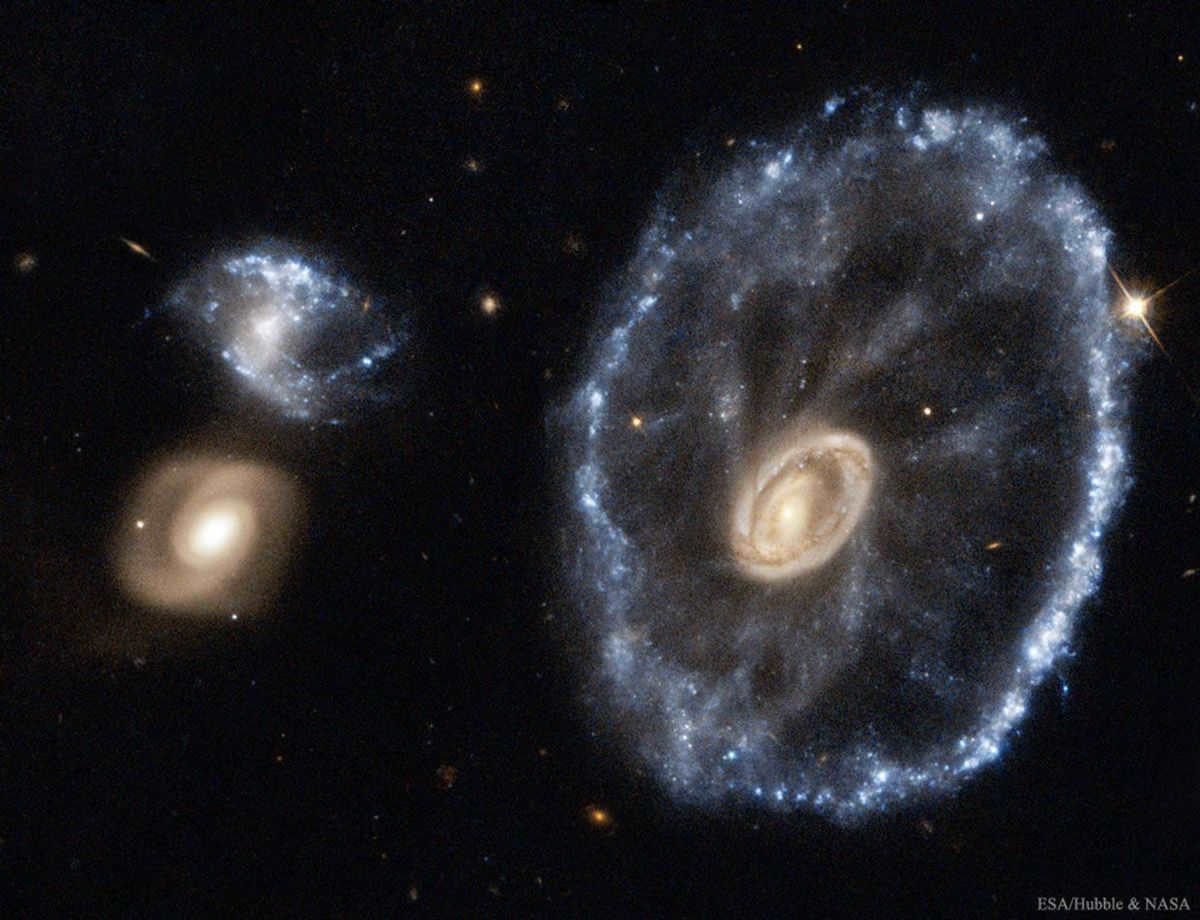
Hubble’s image
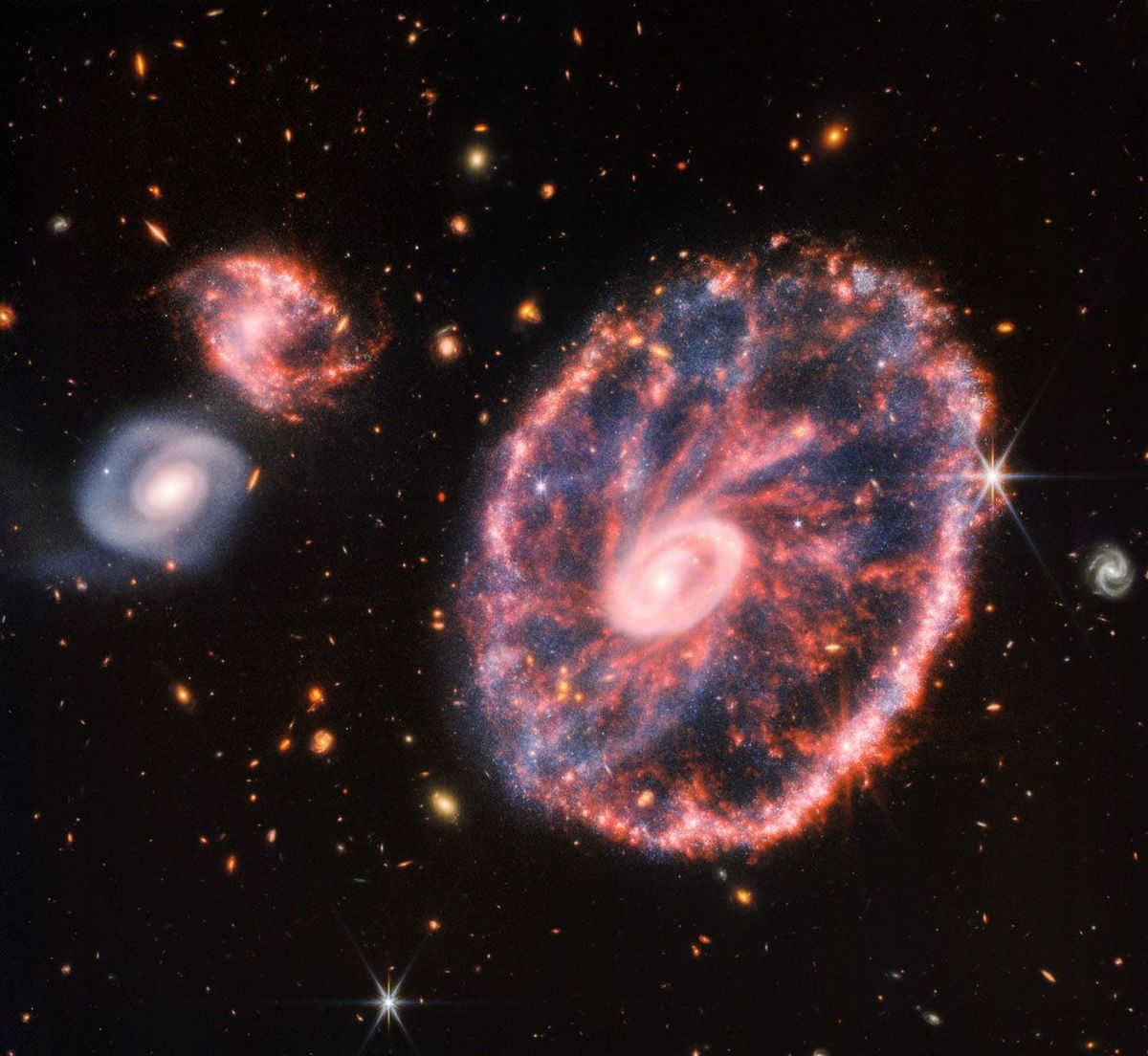
Webb image. The photograph captures the central region of a spiral galaxy prior to its collision with a smaller galaxy, resulting in a distinctive wheel-like formation. High-resolution versions of the image are available.
The photograph depicts the Cartwheel galaxy, which resembles a fiery wheel during the torch performance. This galaxy is located 400 million light-years away and was formed approximately 200 million years ago when a significantly smaller neighboring galaxy collided with a galaxy that is one and a half times the size of the Milky Way and of the same type.
The collision created a “shockwave” that gave rise to a ring of bright young stars, although the original structure is only faintly visible in the Hubble image due to the presence of dust.
The James Webb telescope unveiled the parent galaxy’s arms in a much more brilliant display, and the updated version now resembles the fiery spectacle that naturally occurs when two galaxies collide.
9. The annihilation of the same satellite
On September 26, we reported that NASA plans to intentionally crash the DART spacecraft into the asteroid Dimorphos to assess our ability to divert extraterrestrial objects from colliding with Earth.
Dimorphos, which orbits the sun, does not pose a threat, but it does intersect with the orbits of Earth and Mars and comes close to our planet every 60 years.
To achieve the aforementioned result, we had to make additional preparations and calibrate the telescope for several weeks, as its sensors are programmed to track motion at a rate three times slower than the asteroid’s rotation speed.
Therefore, the outcome of capturing 10 images in a span of 5 hours appears as a brief burst of light to us. However, for scientists, it serves as a valuable source of information. They analyze this data by comparing it with observations from other telescopes, enabling them to draw the necessary conclusions.
By the way, if you search for “dart mission” on Google, you will discover the relevant results.
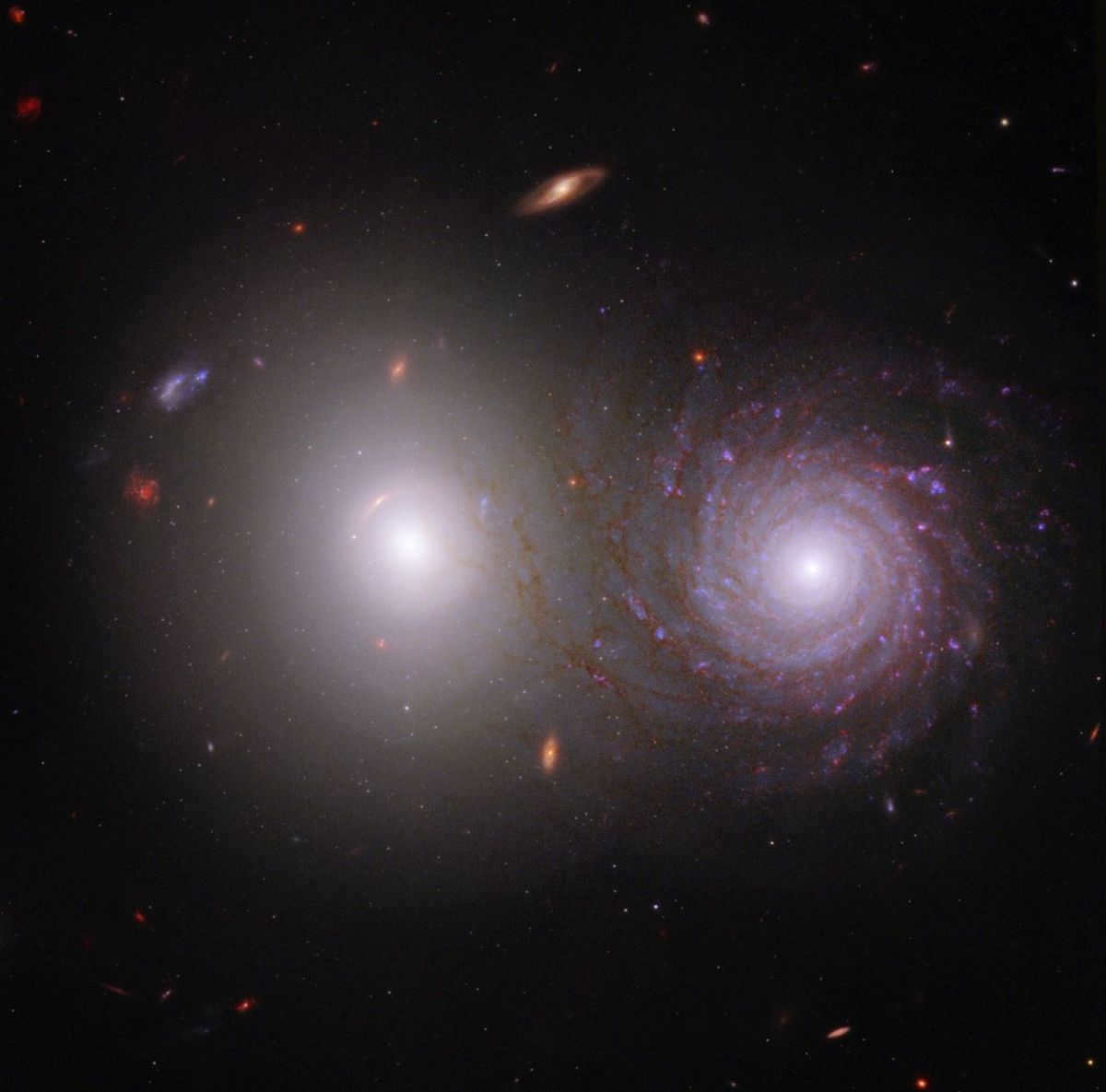
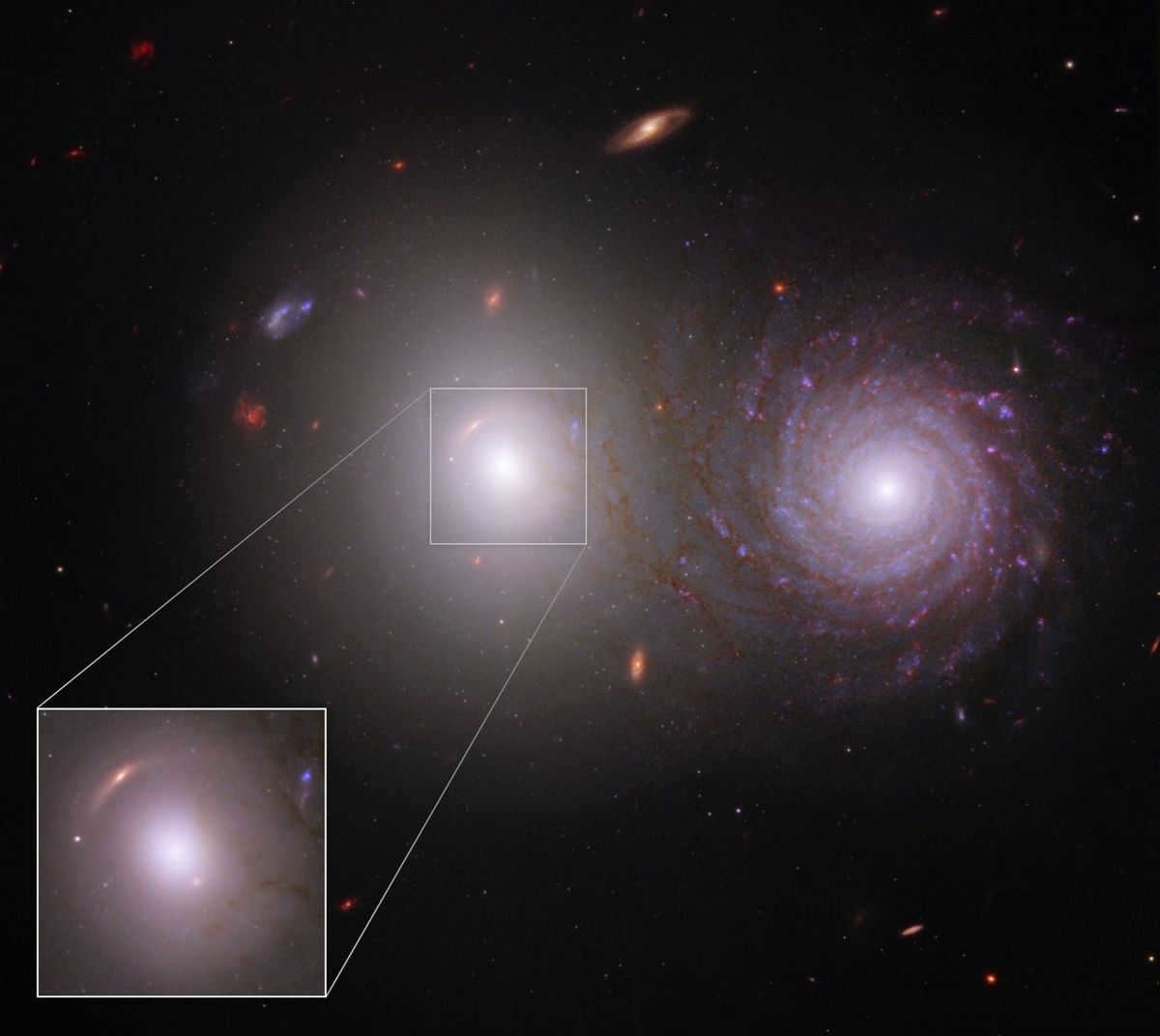
The merged data from the Hubble and Webb telescopes has provided an image of the pair VV 191. The Hubble telescope captured the ultraviolet and visible spectrum, while the Webb telescope captured the infrared spectrum. The processed information has been transformed to make it visible to the human eye.
Among the pair, the galaxy on the left is located further away from its right “partner”, creating a visual contrast. The arms of the right galaxy stand out against the backdrop of the left one, emphasizing their presence.
Additionally, there is another distant galaxy that appears to be two separate galaxies. The Webb telescope’s ability to see far distances has revealed this intriguing observation.
Located in the infrared spectrum, there is an arch of a crimson hue positioned in close proximity to the central region of the galaxy on the left-hand side. The reason behind its distinctive coloration lies in its immense distance, spanning millions of light years away from the principal entities depicted in the image. Moreover, its peculiar shape can be attributed to the gravitational influence exerted by the neighboring left galaxy. Direct your attention towards the lower right section of this central region, and you will observe a scarlet dot. Remarkably, this minute dot represents the very same ancient galaxy, existing in the remote depths of space.
11. The internet according to A Very Strange Thing
In the 21st century, the internet has become an integral part of our daily lives. It has revolutionized the way we communicate, access information, and conduct business. A Very Strange Thing provides its unique perspective on the web and its impact on society.
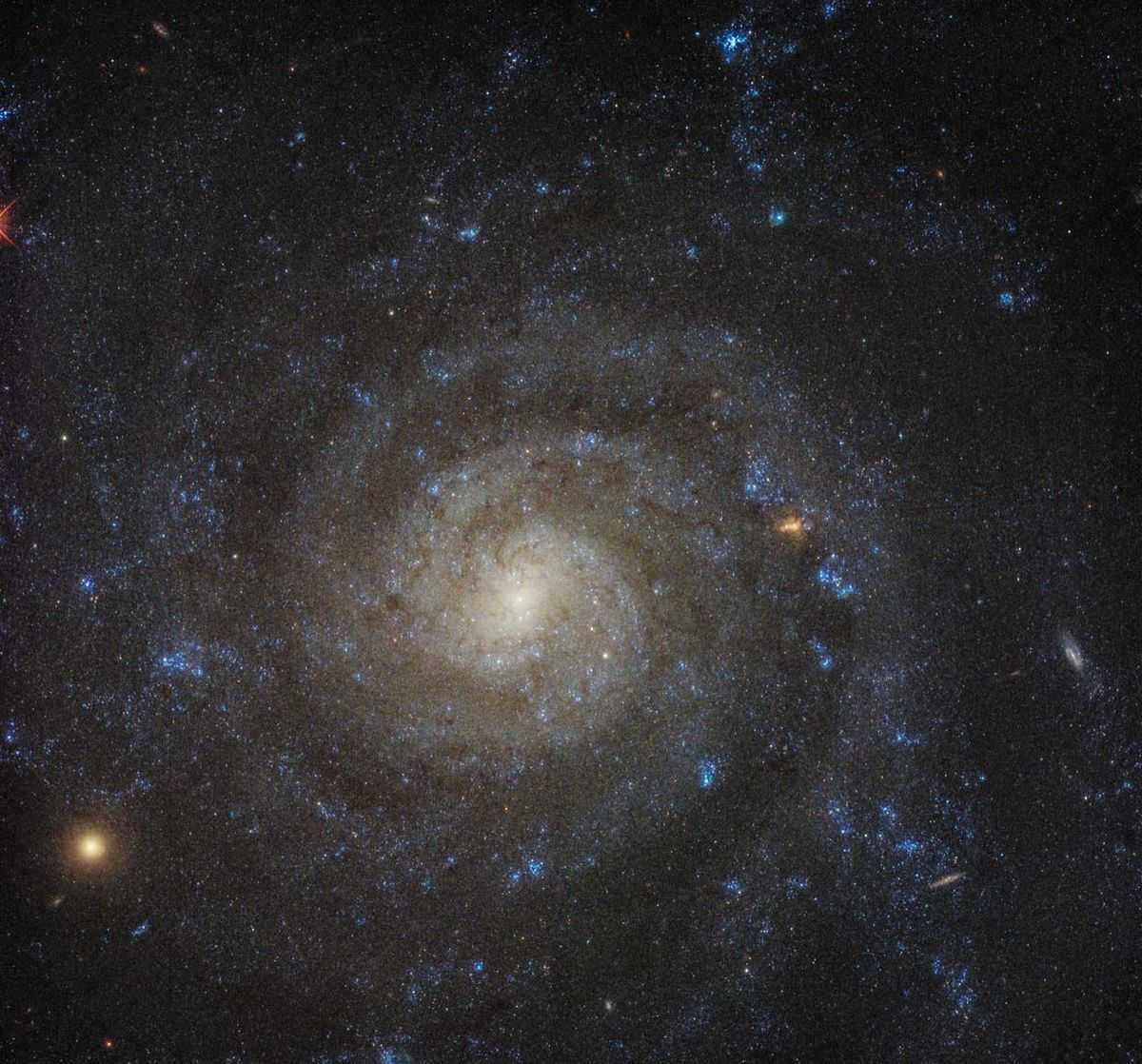
Hubble photo
There exists a stunning spiral galaxy called IC 5332 that can be found 29 million light-years away. This galaxy strongly resembles our own Milky Way with its elegant arms. The Hubble telescope captured an image of IC 5332 in the visible spectrum, which is shown above. From their perspective, they would see the same sight when looking towards us.
Do you recall when I mentioned that outer space isn’t completely black? It’s just that our human eyes are unable to perceive everything?
Well, this is what IC 5332 appears like when observed in its infrared radiation. It’s not The underside.
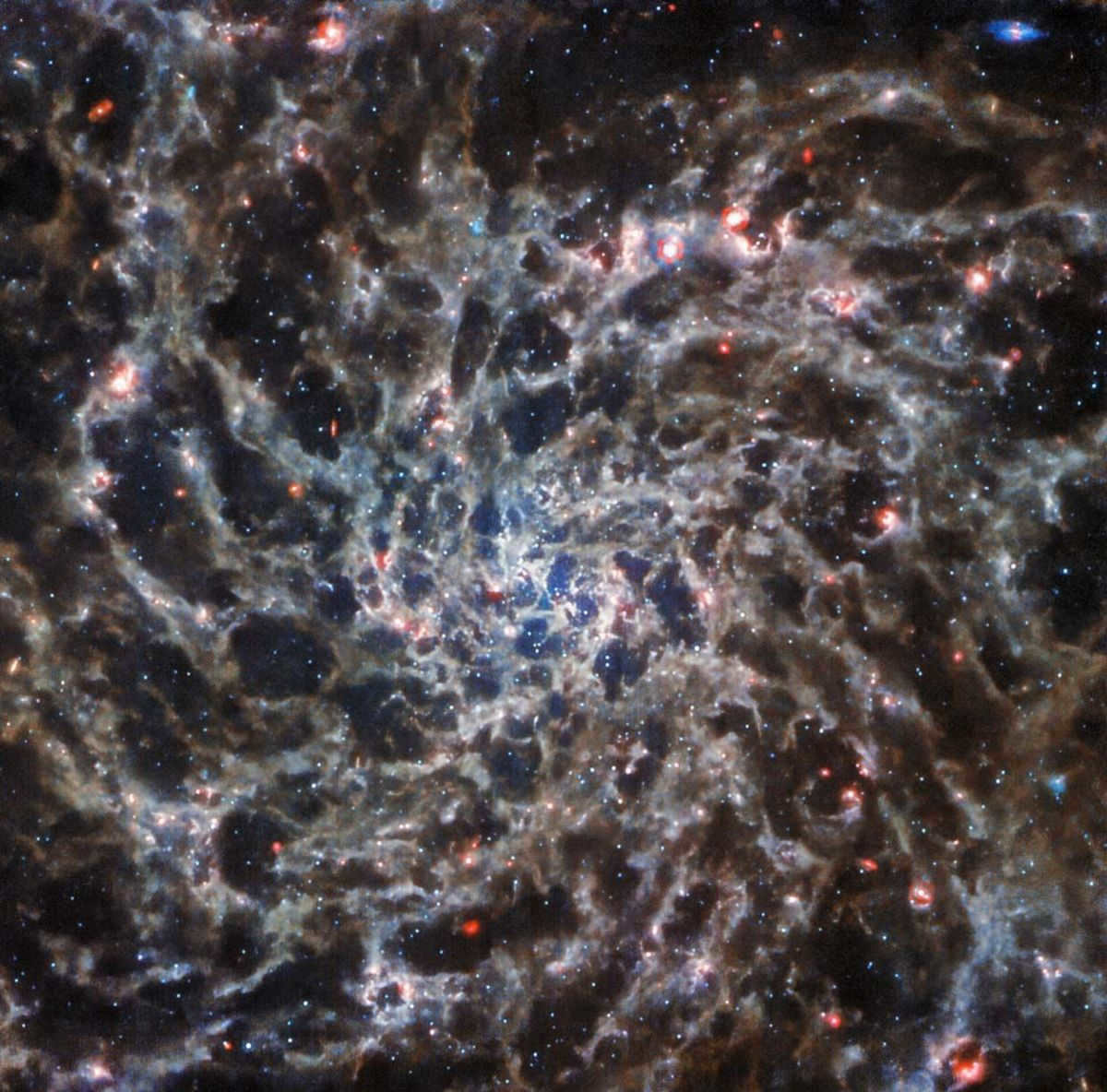
Webb’s photo. Here’s the full-resolution version
An uncanny web that actually exists precisely where the ordinary visible spectrum of light is present. And the most astonishing aspect is that, in our galaxy, it functions in precisely the same manner.
Indeed, the spiral remains discernible, but it is diffused by a radiation web that can only be observed in the mid-infrared range. The red dots (stars) were not all visible in that range either, as Hubble was unable to capture them. It lacks sufficient cooling capacity for that purpose.
Those silver panels at the base of Webb’s structure are precisely what enables it to cool down sufficiently for its sensors to capture such images.
12. Merging galaxies: a unique phenomenon in the universe
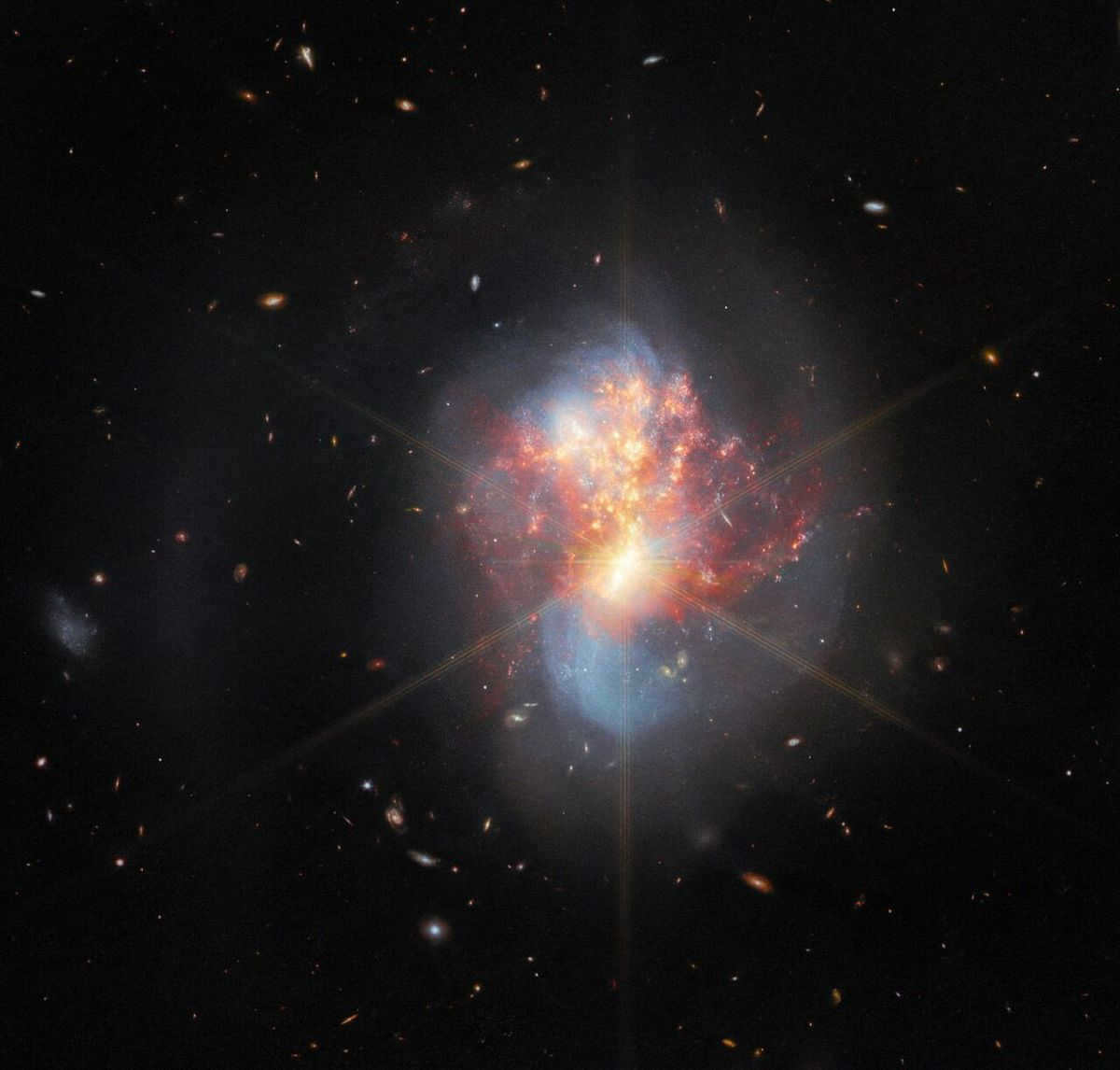
Observation of IC 1623. The high-resolution versions are available below
Located 270 million light-years away, a single galaxy is emerging from the combination of two galaxies known as IC 1623. Due to the intense activity occurring in the final stages, this galaxy emits extremely powerful radiation that is visible in the infrared spectrum, allowing for detailed photographic documentation.
In 2008, the Hubble telescope captured an image of IC 1623; however, the presence of dust hindered scientists’ ability to fully comprehend the ongoing processes.
This new telescope is able to penetrate through the dust, providing a clearer view of the colossal process. It provides further evidence that the merging of galaxies will likely culminate in the formation of a supermassive black hole.
13. The Brightness and Rings of Jupiter

Below you can find the complete versions in high resolution
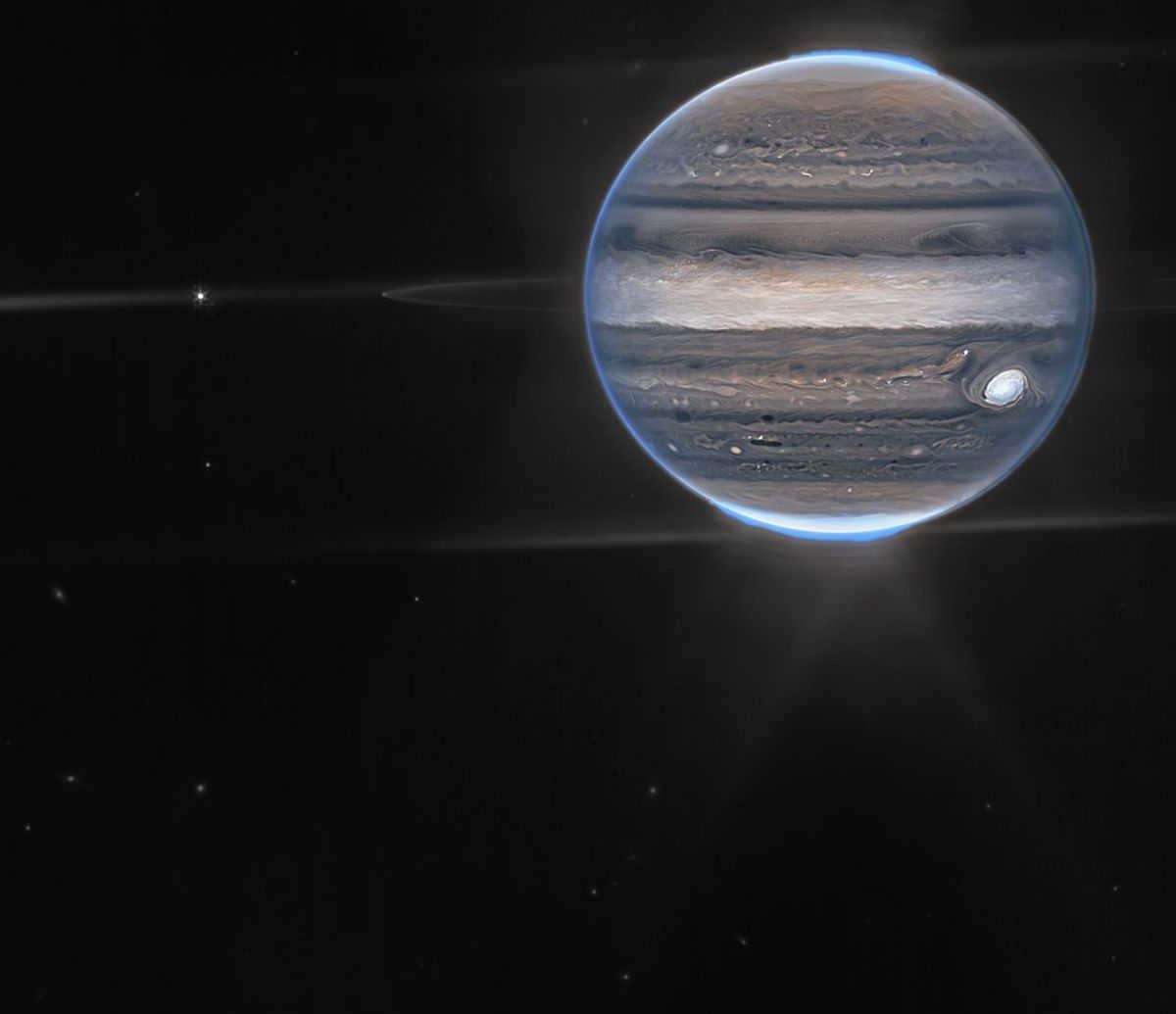
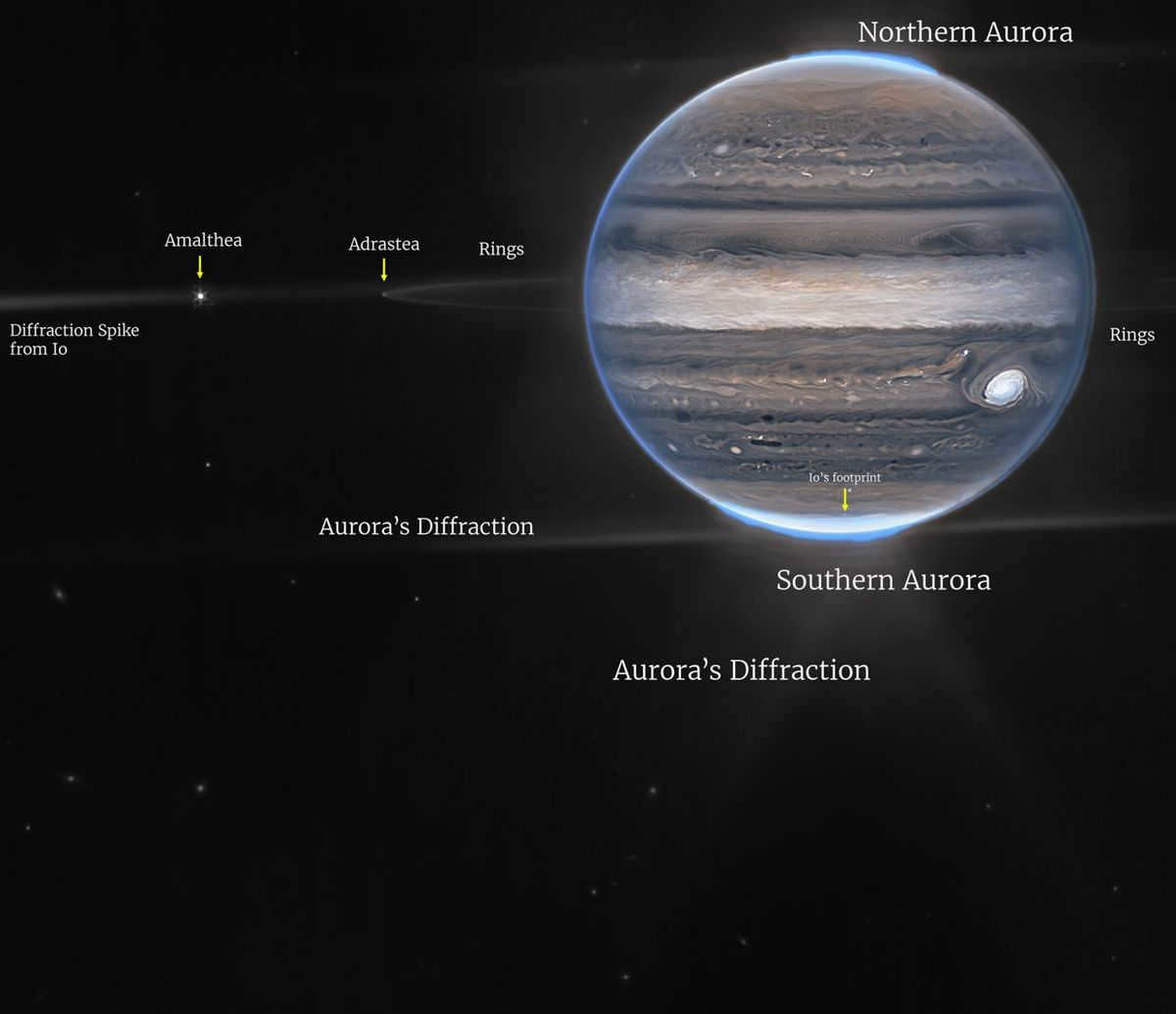
Observing this mesmerizing electrical aura with our own eyes is an unattainable feat, as our visual perception is limited to the visible light spectrum, unlike the near-infrared light that the Webb telescope employs. The astronauts were pleasantly surprised by the exceptional capture of the radiant phenomenon known as the “Jupiter glow.”
The remarkable image was produced through the merging of three distinct photographs taken in varying spectra: red, lettuce, and cyan. The red spectrum showcases the reflection of the glow emanating from the lower clouds and upper mists, the lettuce spectrum reveals the presence of fogs at the celestial body’s poles, while the cyan spectrum signifies the reflection of light from the deepest primary clouds.
In the second image, you have the opportunity to observe satellites and even bands encircling Jupiter, genuine photographs of which are likely exclusive to this source. The gas behemoth possesses a ring that is a million times slimmer than the planet itself, making them incredibly challenging to discern.
Incidentally, the renowned Red Spot, which appears white in this depiction, is of such magnitude that it could engulf our entire planet Earth.
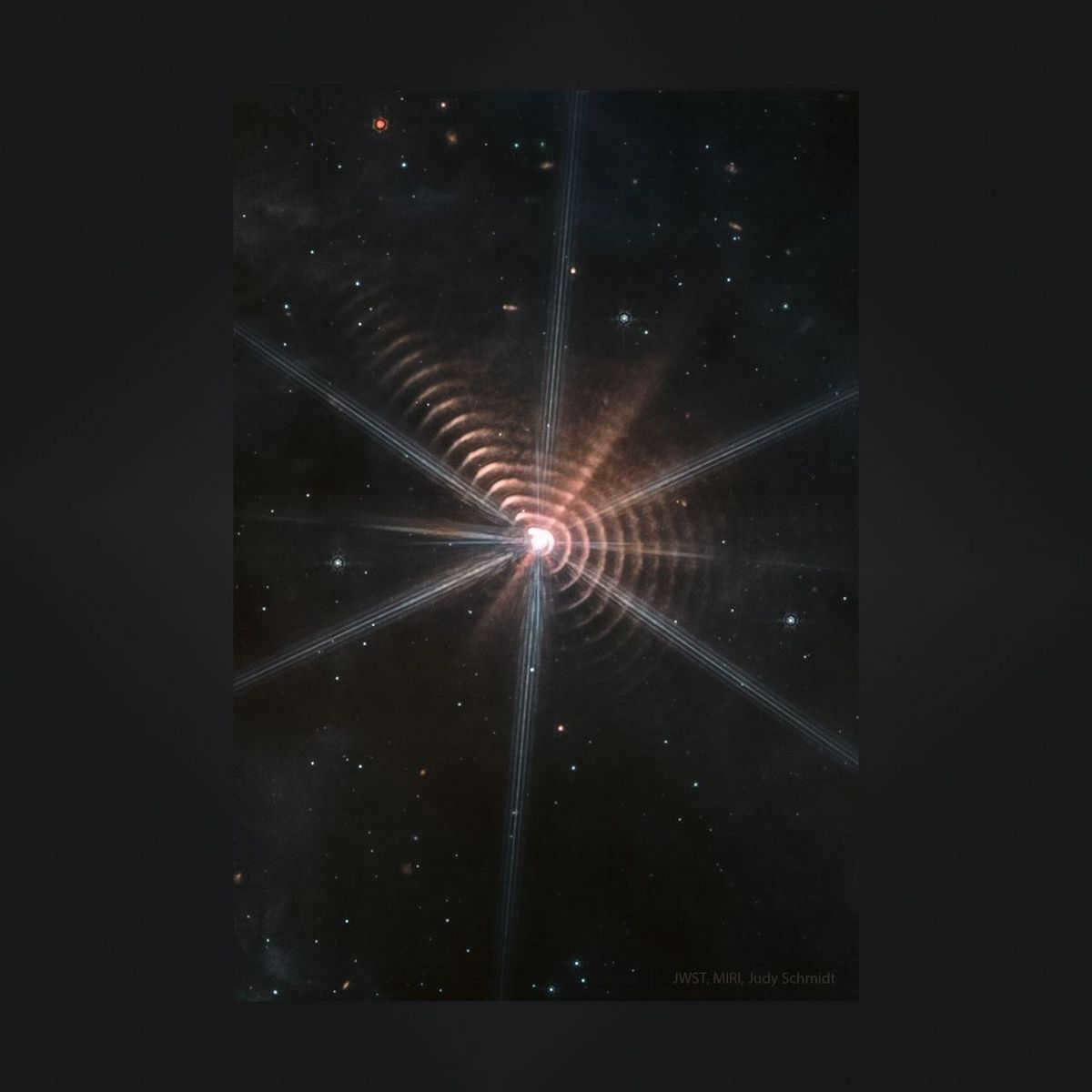
WR140 is a unique dual system. The high-resolution versions of the images can be found below:
Located six thousand light-years away, WR140 is a fascinating two-star system. One of the stars in this system belongs to the Wolf-Rayet type, which are massive stars that have used up their hydrogen shells and now sustain themselves by recycling helium in their cores.
These stars orbit around each other and every eight years, they come close to each other, resulting in the formation of visible rings. The exact composition of these rings is still unknown, but their brightness can provide clues about the timing of their formation.
15. Pillars of Creation
The Pillars of Creation are a well-known astronomical object located in the Eagle Nebula, about 7,000 light-years from Earth. They were first discovered by the Hubble Space Telescope in 1995 and have since become one of the most iconic images in astronomy.
The Pillars of Creation are massive columns of gas and dust that are being sculpted by the intense radiation from nearby stars. The columns are so dense that they are able to resist the destructive forces of the surrounding gas and dust, allowing them to remain intact for millions of years.
These pillars are also home to the birth of new stars. Within the dense gas and dust, gravity causes the material to collapse, forming protostars and eventually, fully formed stars. The intense radiation from these young stars further shapes the surrounding gas and dust, creating the distinctive pillar-like structures.
The Pillars of Creation serve as a reminder of the ongoing process of star formation in our universe. They are a testament to the power of gravity and radiation, and they provide valuable insights into the early stages of stellar evolution.
In conclusion, the Pillars of Creation are a fascinating astronomical object that continues to captivate scientists and enthusiasts alike. Their unique structure and the processes occurring within them make them a valuable source of information about the formation and evolution of stars.
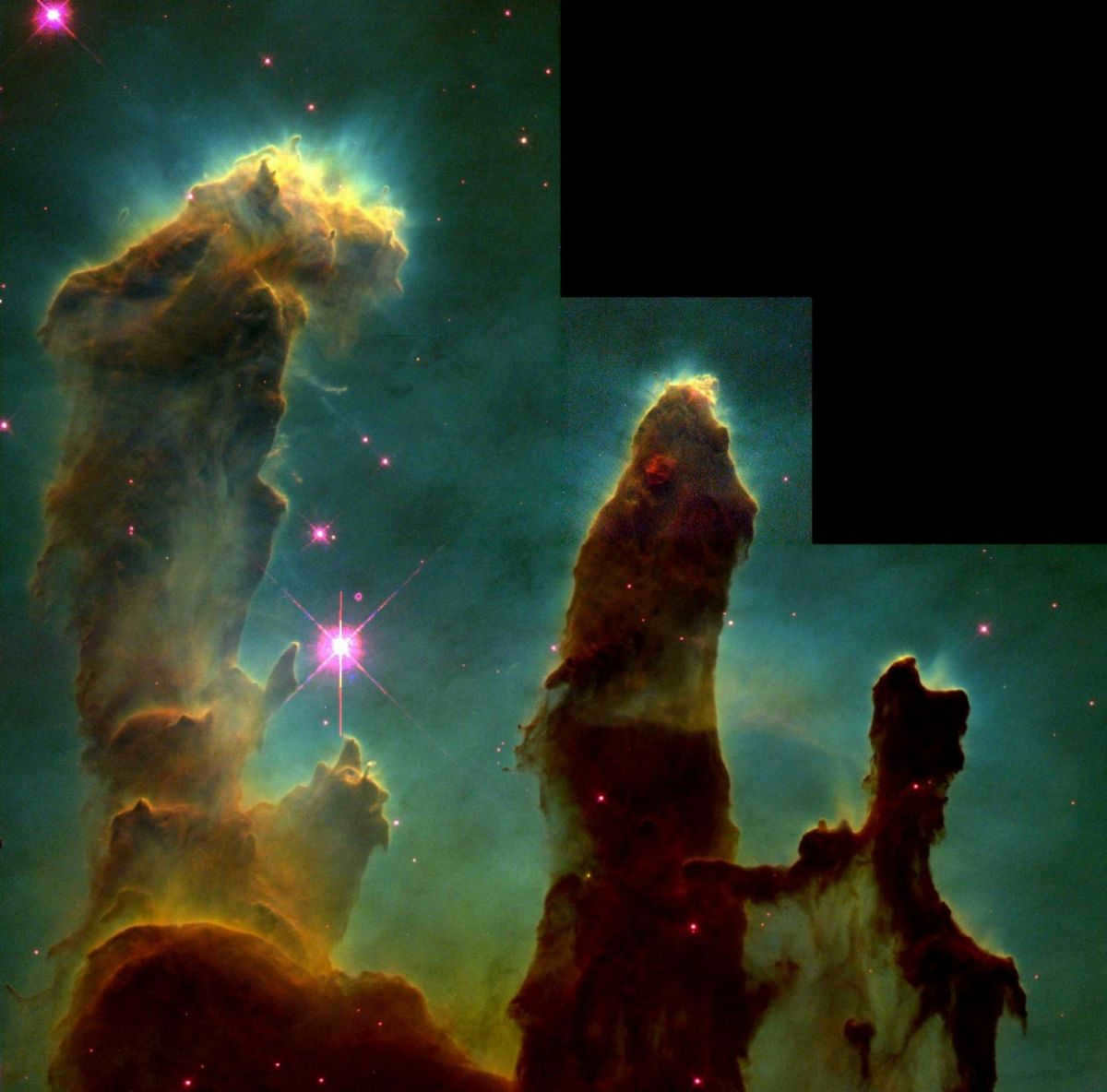
Pillars of Creation. Hubble, 1995
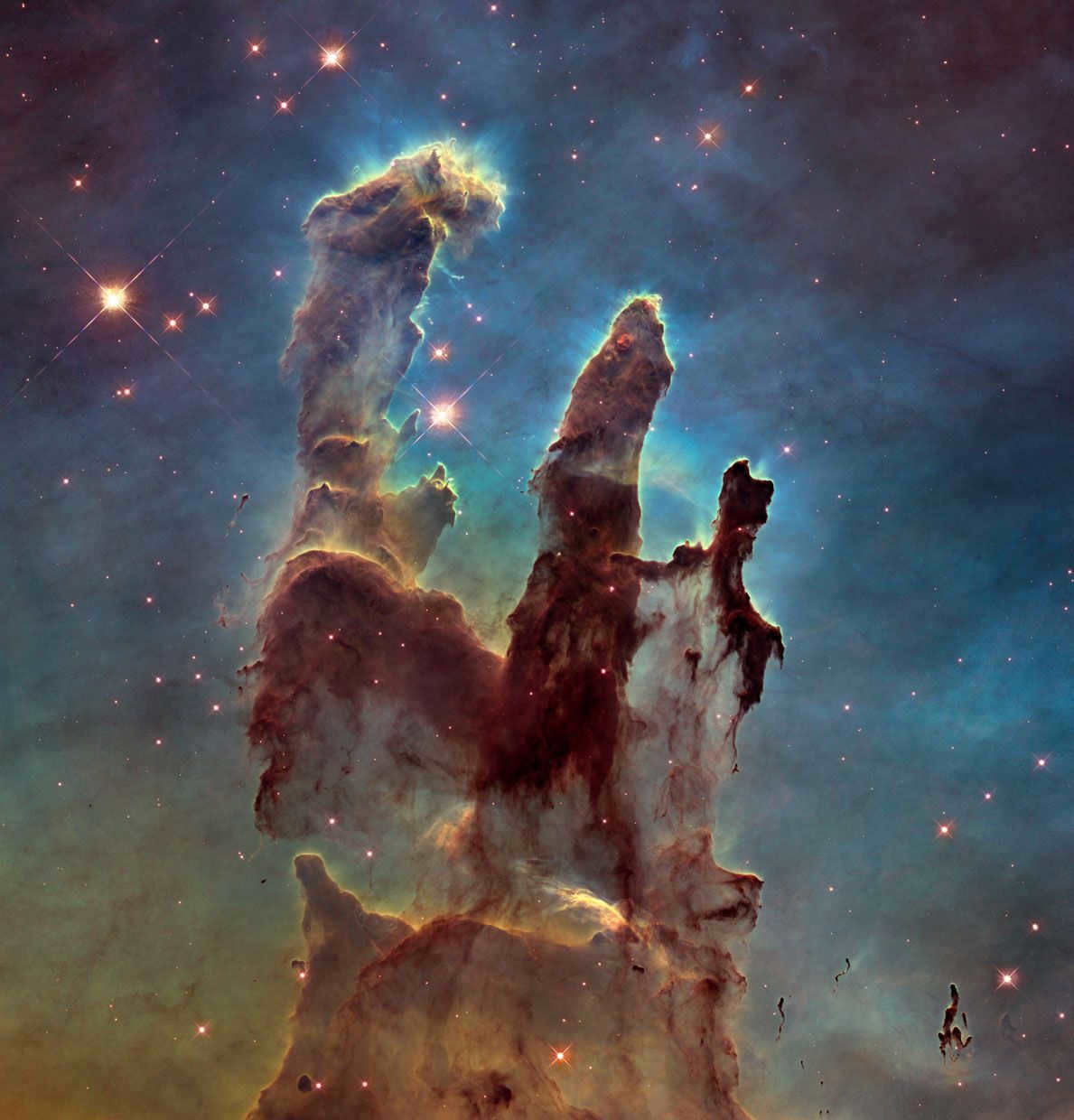
The Pillars of Creation were captured in 2014 by the Hubble Space Telescope.
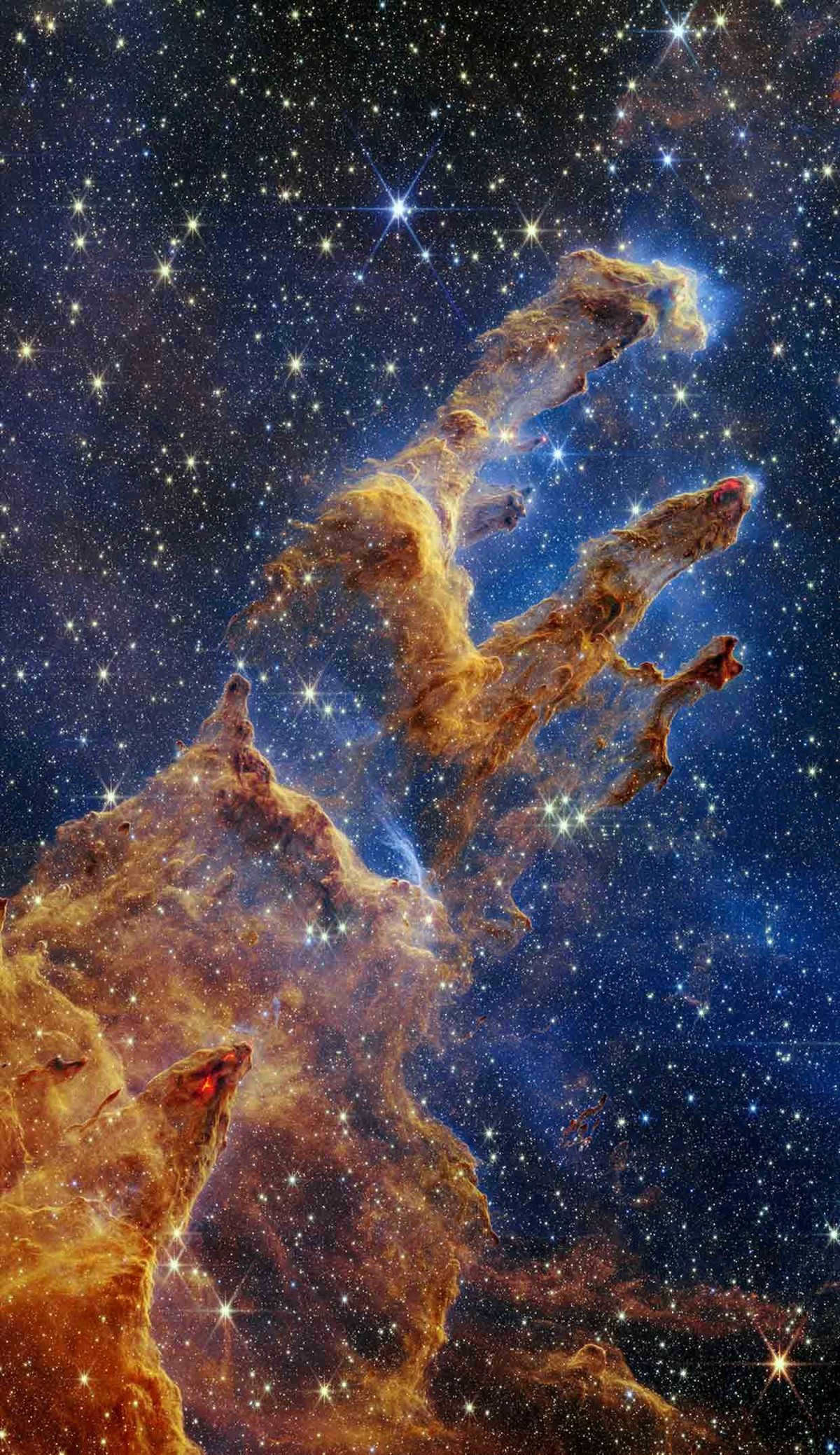
The Pillars of Creation were captured in the near-infrared spectrum by the Webb telescope in 2022. Below, you can find the full-resolution images.
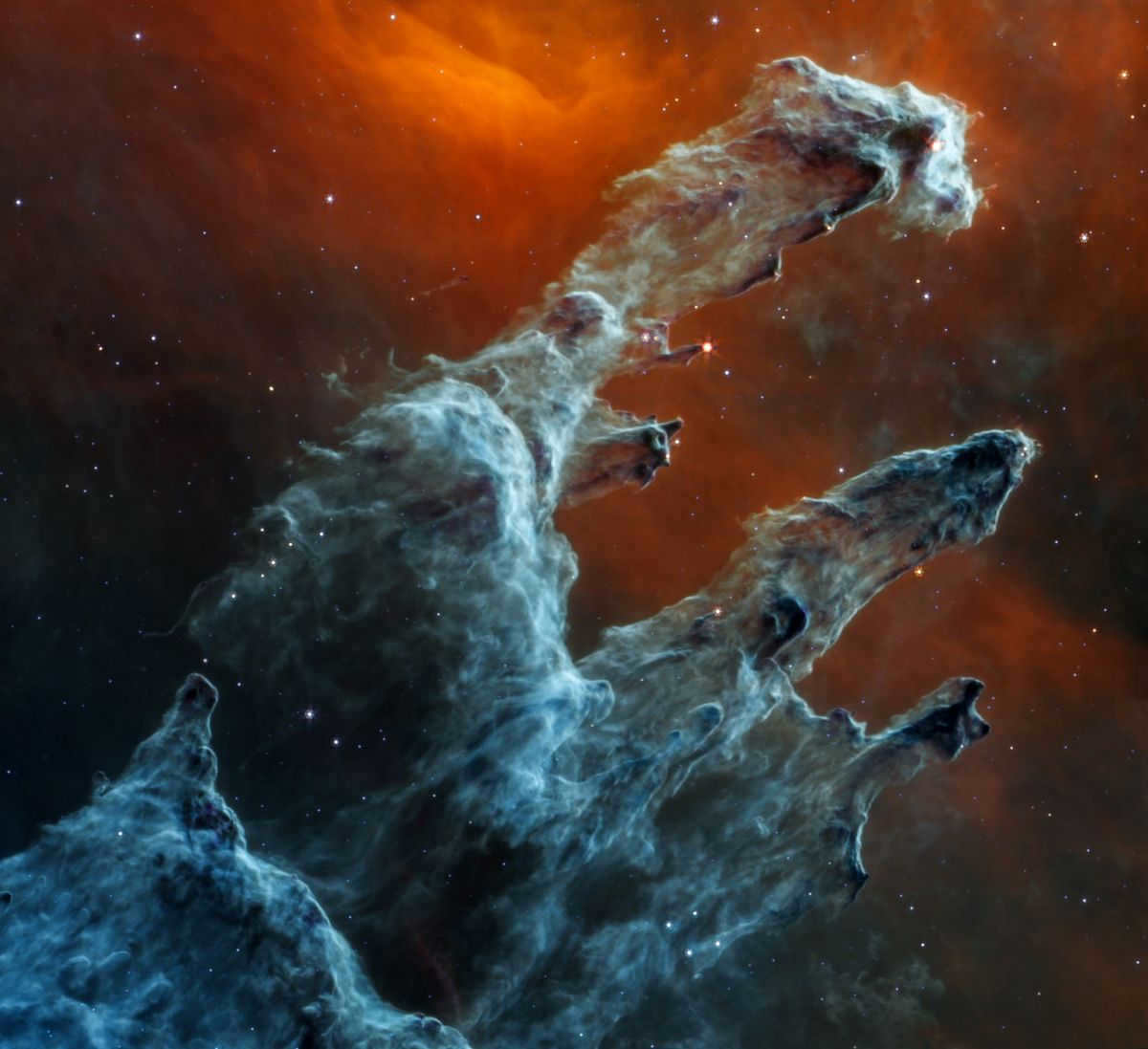
The Pillars of Creation can be observed in the mid-infrared spectrum using the Webb telescope in 2022.

Pillars of Creation. The synthesis of the near and mid-infrared spectrum, 2022, Webb.
The first image of these mesmerizing palaces or celestial kites from the Eagle Nebula. from the Eagle Nebula (6500 years away from Earth) captured by the Hubble telescope for the very first time in 1995 and once again in 2014.
The newer, more intricate, and brighter version was captured using the near- and mid-infrared cameras on the Webb telescope.
In the midst of this dust, stars come to life. Subsequently, the stars will disperse matter around them, akin to galaxies, which will eventually give rise to planets and star systems.
Therefore, despite the fact that we have observed more through this structure, the Webb telescope is incapable of revealing the numerous galaxies that remain concealed by the Pillars of Creation. the Pillars of Creation..




























The universe is not devoid of color. It is our limited perception that renders it black, as our vision and the majority of sensors are ill-equipped to detect the diverse range of radiation emitted by countless entities within our vast cosmos. This is precisely why the James Webb Orbiting Observatory was launched in December 2021. Its purpose is to capture intricate images of celestial bodies in close proximity to us, as well as those situated hundreds of millions of light years from our planet.
Pavel
I celebrate 4 different occasions that feel like New Year to me: the usual one, my personal one, the WWDC event, and Apple’s September presentation. Out of all of them, the latter is the most eagerly awaited, and I have absolutely no shame in admitting it.
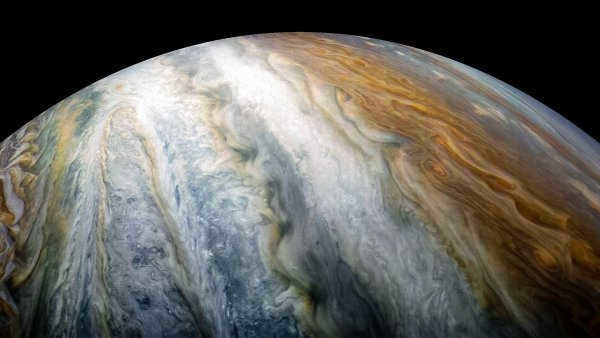

On July 5, 2016, NASA’s Juno spacecraft successfully entered the polar orbit of Jupiter, completing a journey of 2.8 billion kilometers at a staggering speed of 210,000 km/h. This marked a significant milestone in space exploration, as Juno became only the second spacecraft to orbit the gas giant, and the first to venture so close to its surface.
Jupiter, much like our own planet Earth, possesses a magnetic field of its own, albeit much more powerful. Guiding Juno into the gas giant’s orbit at its weakest point, the polar regions, proved to be an immense challenge for NASA, as shared by mission leader Scott Bolton. Had Juno missed its mark, Jupiter’s intense heat would have easily destroyed the probe.
However, let’s not get sidetracked, as our main focus here is the exceptional and awe-inspiring photographs of Jupiter and the remarkable discoveries made by the Juno spacecraft. These include the first-ever glimpses of the planet’s poles, a remarkably close encounter with the iconic Great Red Spot, captivating images of the gas giant’s polar lights, and so much more. All of these incredible photos were captured by JunoCam’s impressive single tri-color camera, boasting a 2-megapixel Kodak KAI-2020 sensor with a resolution of 1600×1200 pixels. This remarkable camera truly showcased its capabilities when it ventured within a mere 4,300 kilometers of Jupiter, allowing for images with a staggering resolution of up to 15 kilometers per pixel. It’s worth noting that due to certain limitations, Juno was only able to transmit a mere 40 MB of data from JunoCam during each 14-day orbit. Nevertheless, back on Earth, the talented team of NASA specialists diligently processed the transmitted photos, expertly adjusted the colors, and seamlessly stitched together the individual pieces to create captivating complete images.
A massive crimson spot up close
On July 10, 2017, the Juno spacecraft soared above the biggest cyclone in our solar system and the most distinctive area of Jupiter, at a mere distance of 9,000 km. This vortex, equivalent to the size of Earth, has been raging on the planet for 350 years, and researchers have noted a slight reduction in its dimensions over the past few decades.
And behold, a comparable picture, albeit rendered in a more realistic hue.
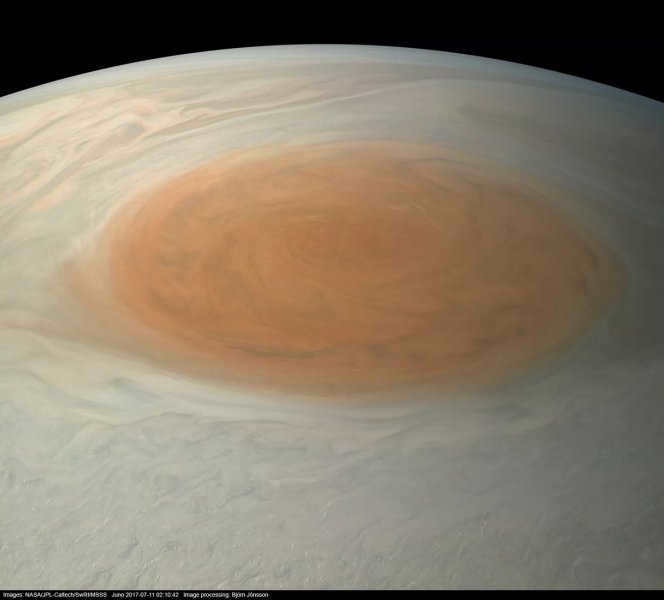

The polar regions
From a distance of 50,000 kilometers, this is the view of Jupiter’s southern pole. Similar to the northern pole, it is adorned with enigmatic vortices the size of our planet, which have left NASA bewildered.
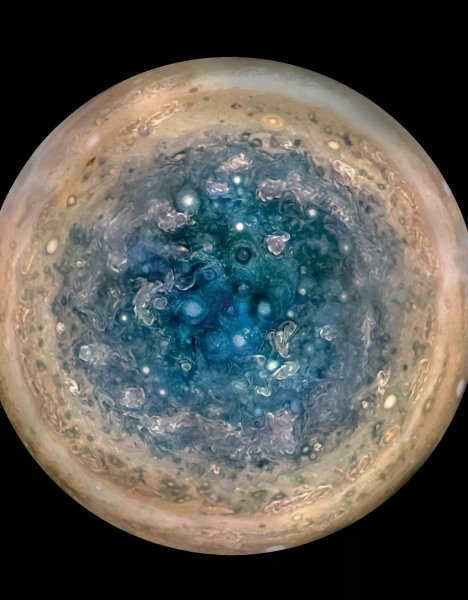
Scientists are still puzzled by the arrangement of eight cyclones circling around the center of Jupiter’s North Pole. These giant vortices, despite their geometric precision, continue to remain stable.
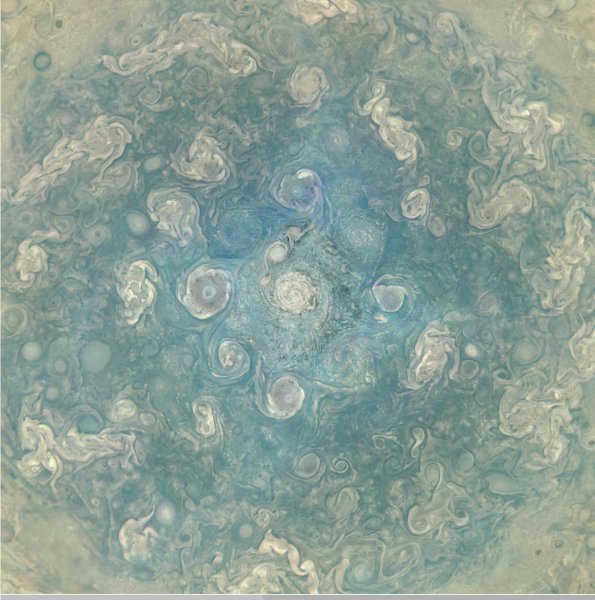
Due to the presence of infrared sensors on the Juno interplanetary station, it is possible to obtain three-dimensional images of the cyclones at Jupiter’s north pole, as seen here. These unique images cannot be captured from Earth using telescopes.
Exploring Jupiter from top to bottom
As Juno completes its pole-to-pole orbit around Jupiter, it captures this view of the gas giant. Jupiter is composed primarily of hydrogen and helium, similar to the Sun. With 69 satellites, it serves as a miniature representation of the solar system. Scientists hope that a comprehensive study of its surface will provide insights into the origins of our solar system and a greater understanding of the cosmos as a whole.
Jupiter’s True Appearance
While color-corrected images of Jupiter have always captivated audiences, there are also stunningly detailed images of the planet in its natural hues. Although it may not appear as awe-inspiring, it resembles a colossal swirl of coffee and creamer.
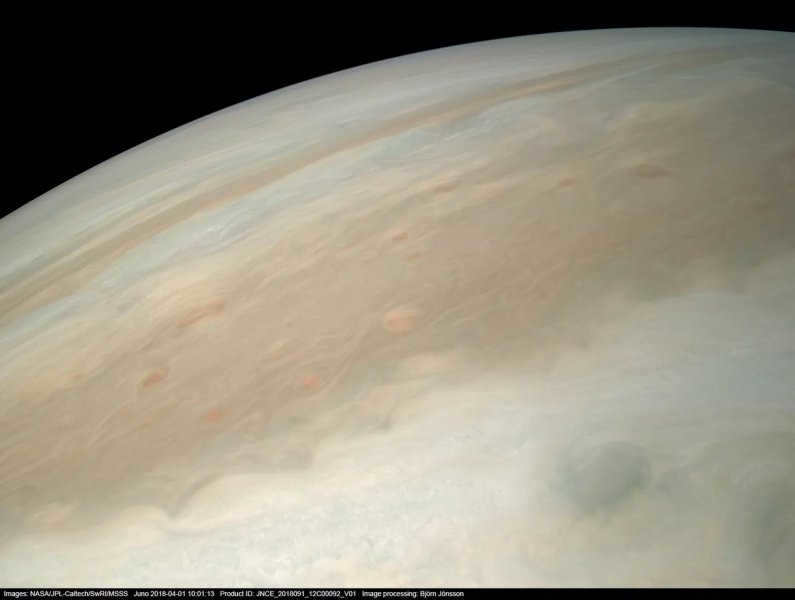
Contrasting Atmosphere
The Juno mission has captured these stunning images of Jupiter at a distance equivalent to the Earth’s diameter. The vibrant spots seen in Jupiter’s dense bands could potentially be caused by the release of sulfur and phosphorus-containing gases from the warmer layers of its atmosphere. These cloud formations, reminiscent of Van Gogh’s paintings, encircle the planet in massive streams, similar to those found on Earth.
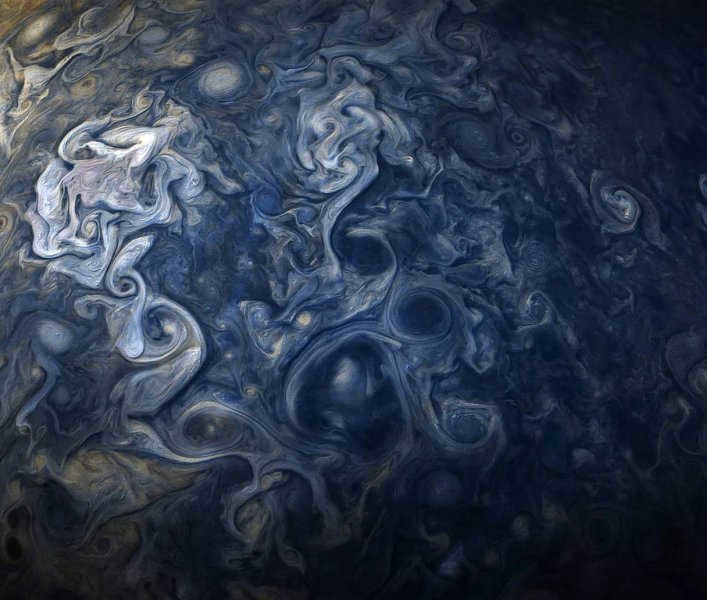
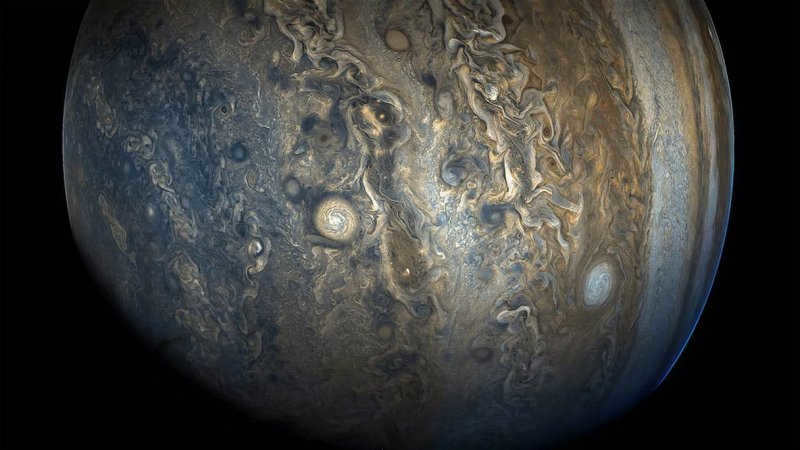
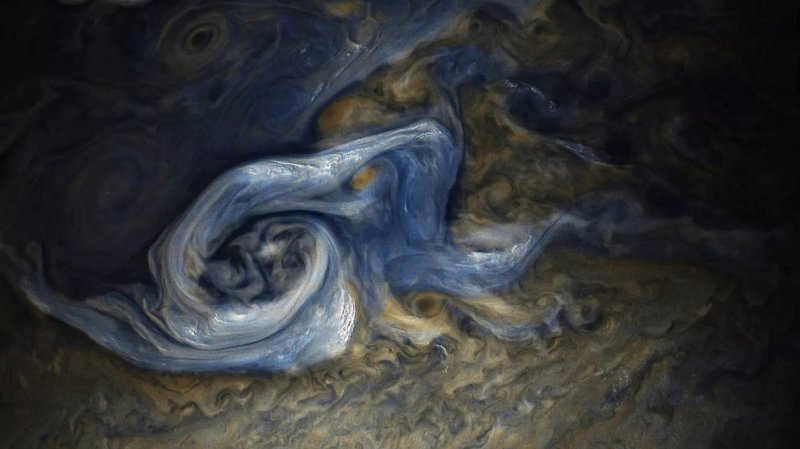
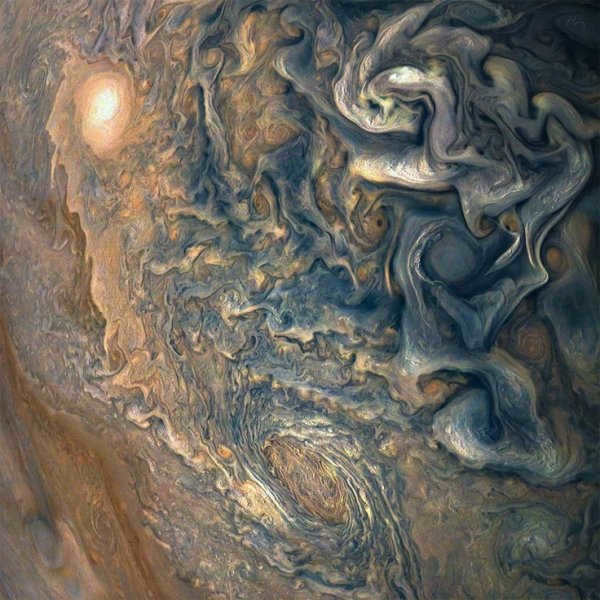
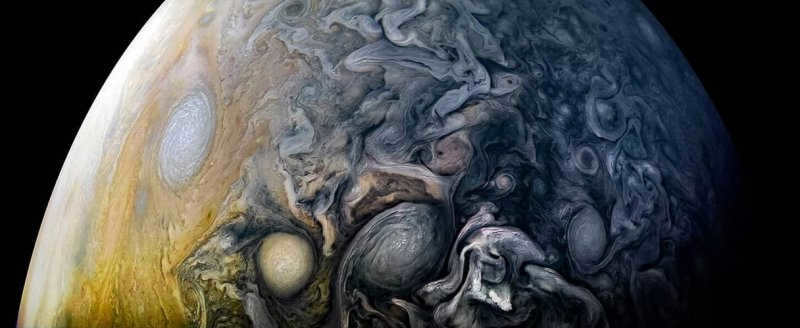
Moving Away from Jupiter
This image was captured by the spacecraft as it completed its tenth orbit around the planet.
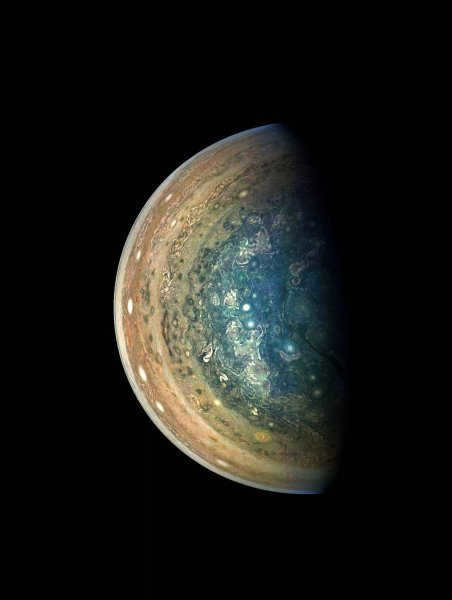
Looking through a telescope at the magnificent Jupiter is an experience that can turn a curious space lover into an amateur astronomer. It is truly awe-inspiring to observe planets with a telescope and witness a nearly real-time image of a celestial object that is millions of kilometers away.
How to locate Jupiter
Fortunately, Jupiter is easily visible in the night sky as it is one of the brightest planets. Unlike stars, it appears larger and doesn’t twinkle as much.
Because of its size and brightness, Jupiter is a popular planet for amateur astronomers to observe. When viewed through a telescope, it offers a stunning sight.
Due to its extensive orbit around the sun, it takes approximately 12 months for Jupiter to move from one constellation to another from our perspective on Earth. This makes it relatively simple to determine its location for an entire year. Here are a few methods to help you find Jupiter in the sky:
- Mobile Apps
- Constellations
- Star Charts
- Go-To Telescopes
Stargazing apps like Star Walk 2 can now be installed on any modern smartphones. When you enter your location or let the app find it automatically, it will show you the view of the night sky. What’s great about these apps is that they update the position of each celestial object in real time as they appear in front of you. Simply hold your phone up and explore the night sky. It shouldn’t take more than a minute to find Jupiter.
- To download the app on Android, click here.
- To download the app on iPhone, click here.
There are several software options available for pre-planning your planetary observations. One such option is Stellarium, which can be downloaded and installed on your computer. Once you have input your specific location and time, Stellarium will generate a visual display of the sky as it would appear if you were observing it in person. With this information, you can effectively plan and anticipate Jupiter’s trajectory across the celestial sphere. Additionally, Stellarium provides the ability to view the precise positions of all celestial objects at any given time, allowing you to adjust the time settings to observe past or future events.
If you are interested in easily locating and observing Jupiter through your telescope, we recommend downloading Stellarium.
For centuries, constellations have served as guides for those curious about the night sky. From our viewpoint, Jupiter’s orbit will always intersect or come close to one of the 12 constellations that make up the Zodiac. If you are aware of the current constellation Jupiter is in, all you need to do is observe that particular constellation and spot the additional point of light with your telescope. Star charts can be helpful if you are unsure how to locate constellations.
From November 2019 until September 2020, Jupiter will be situated in Sagittarius before moving into Capricornus.
Star charts are an incredibly useful tool for navigating the night sky. While they may not provide exact coordinates for planets, amateur astronomers can utilize them to track and locate the constellation in which Jupiter is currently positioned. Additionally, star charts can assist in identifying the “ecliptic,” an invisible line that represents the apparent path of the Sun and is followed by all planets, including Jupiter.
- Discover how to effectively utilize a star chart here.
- Access and print the current star chart for your specific location here.
Go-To telescopes are advanced telescopes that have built-in guidance systems to help users find celestial objects more easily. While they may be more expensive, they can save a significant amount of time. With a simple press of a button, you can easily locate Jupiter or any other target of interest. These telescopes are equipped with an electric motor and a control handset for smooth operation.
The go-to telescope has the ability to automatically locate, move, and align itself to any desired target. This makes it an excellent choice for amateur astronomers who want to effortlessly track planets and other celestial objects.
1. Minimizing the impact of the atmosphere
When observing Jupiter with a telescope, the light emitted by the planet goes through a longer atmospheric path when it is positioned low on the horizon. Conversely, when Jupiter is higher in the sky, the light has a shorter journey through the atmosphere. This variation can have an impact on the quality of the observations made with a home telescope. To optimize your viewing experience, it is recommended to plan your observation session when Jupiter is in an ideal position in the sky. Additionally, it is important to consider the location on Earth from which you are observing, as it can also affect the visibility of Jupiter. Please refer to our example image for further illustration.
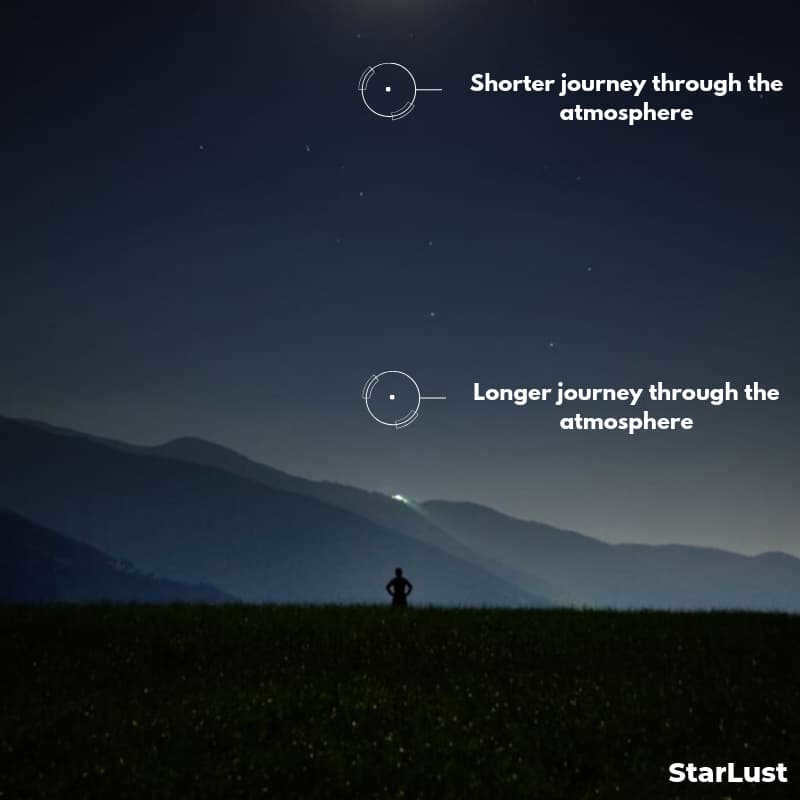
2. Dimmed skies
The problem of light pollution is gaining prominence in today’s society. This undesirable luminosity can pose a challenge for novice stargazers attempting to observe Jupiter through a telescope. The illumination emitted by street lamps, directed upwards into the atmosphere, diminishes the distinction between the pitch-black backdrop and the targeted planet. Jupiter, being relatively luminous, is less susceptible to this issue, but whenever possible, it is advisable to select a location with minimal light pollution for telescope usage.
You can assess the impact of light pollution on your area and discover a suitable dark location by utilizing this online map.
3. Air Turbulence
In order to enhance the clarity of your observations, it is advisable to select a suitable location for your amateur telescope. For instance, it is recommended to avoid areas with concrete surfaces that have been exposed to direct sunlight throughout the day, as they tend to retain heat and cause disturbance in the air during nighttime.
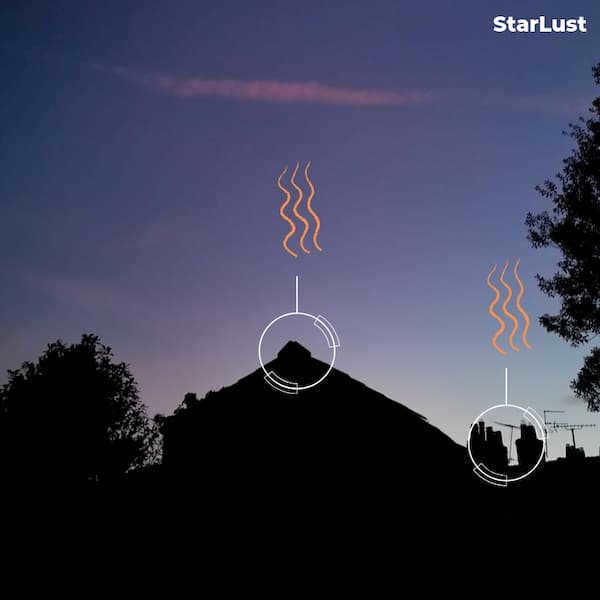
It is also advisable to refrain from observing Jupiter when it is directly positioned over your neighbor’s residence, as the heat emanating from their roof or chimney has the potential to cause a distorted depiction of the highly sought-after celestial body.
The term “seeing” is frequently utilized within the amateur astronomy community to describe the atmospheric conditions during a stargazing session. The atmosphere, a vast mixture of gases, constantly moves and swirls in an unpredictable manner, which can impact the quality of your observations. For instance, if you observe that Jupiter appears significantly blurry through your telescope, despite properly setting up everything, it is most likely a result of poor “seeing,” indicating a high level of atmospheric turbulence.
5. Dark Adaptation & Temperature
When observing Jupiter with either a refracting or reflecting telescope, the temperature outside will have an impact on your equipment. The various metal components and mirrors may expand or contract slightly depending on whether it is hot or cold. This can potentially affect the clarity of the image you see through the eyepiece of your telescope. It is advisable to allow your telescope to acclimate to the temperature by leaving it outside for at least 20 minutes.
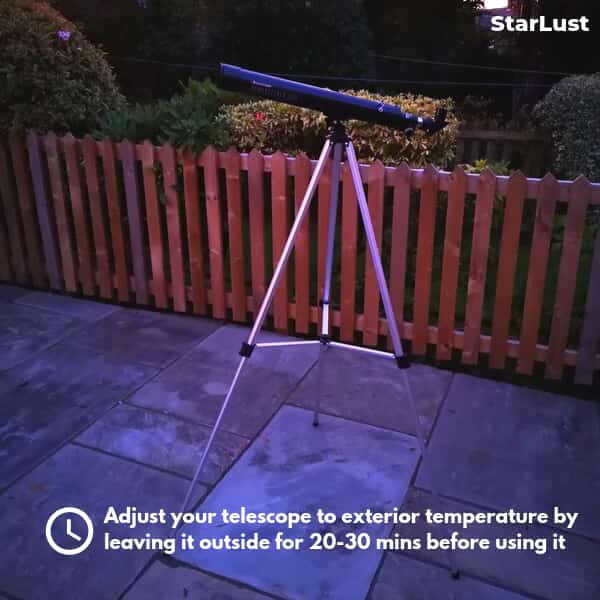
It is important to allow your eyes to adjust to the darkness before observing Jupiter in order to improve your ability to see it. I typically take advantage of this time by letting my telescope acclimate to the temperature and giving my eyes time to adjust to the dark while enjoying a cup of coffee or hot chocolate.
At the start of each January, Jupiter is typically most visible late at night and before sunrise. As the months progress, the planet will gradually become visible earlier in the night sky. In the northern hemisphere, you should be able to observe Jupiter through a telescope starting at 11 pm.
The optimal time to observe Jupiter through your personal telescope is when it is in opposition to the sun in the sky (from our perspective). This occurs when the Earth and Jupiter’s orbits momentarily align on the same side of the sun. During this alignment, Earth is situated directly between Jupiter and the sun, providing amateur astronomers with the ideal angle for observing the planet. Thanks to its proximity to Earth, Jupiter will appear significantly brighter and offer excellent viewing conditions.
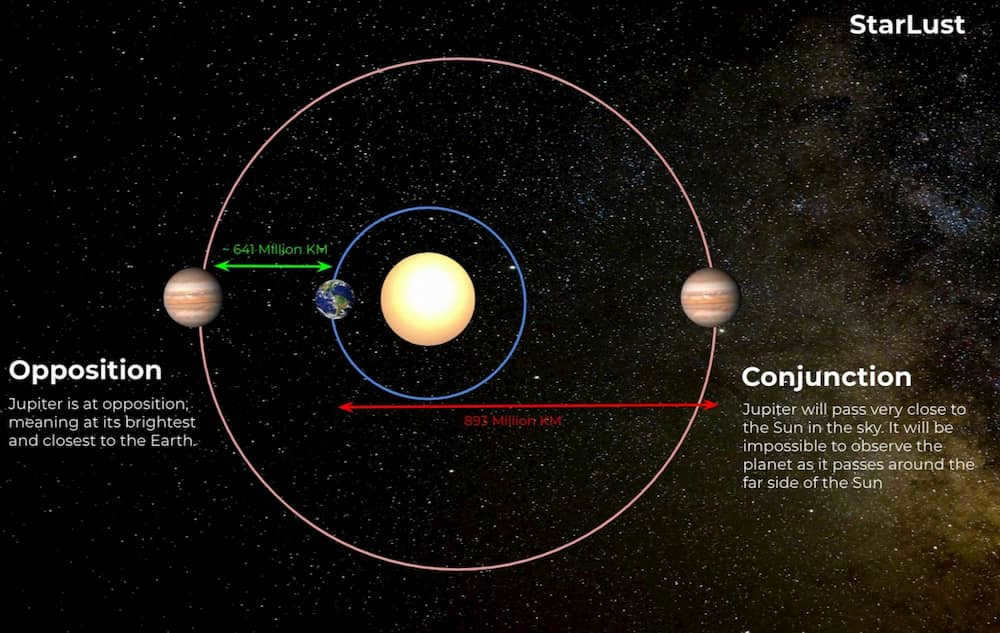
This year, mark your calendars for the 14th of July as it will be the time of Jupiter’s opposition! During the weeks surrounding this special event, Jupiter will be visible throughout the night, providing optimal conditions for observation. Looking ahead, the next two oppositions will occur on the 20th of August 2021 and the 26th of September 2022.
What is the ideal telescope for observing Jupiter?
You don’t have to spend a fortune on a telescope to get a good view of Jupiter. In fact, even with a basic telescope (2.5″), I was able to see Jupiter and its four moons. Additionally, a pair of stargazing binoculars can also provide a decent view of the planet.
The choice of telescope you require is entirely dependent on your desired outcome. If you simply wish to observe Jupiter and its moons occasionally on a clear night, a telescope with a 4-inch aperture will suffice. However, if you are interested in astrophotography and capturing images of Jupiter for stacking and processing using digital photography software, a more powerful telescope with an 8-inch aperture, along with a sturdy tripod and digital camera, may be necessary.
Before making a purchase of a telescope, we suggest participating in star parties or events organized by a local astronomical club. This will give you the opportunity to engage in conversations with seasoned astronomers and also get a hands-on experience with a few different telescopes!
Jupiter, the largest planet in our solar system, is approximately 11 times larger than Earth in terms of diameter and 318 times more massive. It takes Jupiter 12 years to complete one orbit around the Sun, with an average distance of about 800 million kilometers. The planet’s atmosphere is adorned with belts of clouds and features a remarkable phenomenon known as the Great Red Spot, making Jupiter a truly captivating celestial body.
Jupiter, unlike the four neighboring planets closest to the Sun, is not a solid celestial body, but rather a colossal mass of gas. Furthermore, there are three additional gas giants, namely Saturn, Uranus, and Neptune, that are even farther away from the Sun. The chemical makeup of these gaseous planets closely resembles that of the Sun, setting them apart from the solid inner planets within our solar system. For instance, Jupiter’s atmosphere is comprised of approximately 85 percent hydrogen and around 14 percent helium. Although no solid or rocky surface is visible through the layers of clouds enveloping Jupiter, deep within the planet, the immense pressure causes the hydrogen to exhibit certain metallic properties.
Exploring Jupiter
Jupiter, the largest planet in our solar system, has been the subject of exploration by five different spacecraft. The most recent of these, Galileo, embarked on a momentous six-year journey in October 1989. However, it was the Pioneer 10 and Pioneer 11 spacecraft that paved the way for our understanding of Jupiter, making the first measurements and observations. These groundbreaking missions were followed by the Voyager spacecraft, which captured breathtaking close-up photographs of Jupiter in 1979.
Since then, the Hubble Space Telescope has taken over the task of capturing images of Jupiter. The images obtained by the Hubble Space Telescope are of the same high quality as those taken by the Voyagers. In fact, the Hubble Space Telescope has the advantage of being able to continue taking pictures of Jupiter for several years, unlike the Voyagers which had a limited window of opportunity as they flew past the gas giant.
Watching Jupiter
Jupiter completes a full orbit of the sky in 13 months, and it is easily visible in the sky for several hours each night for several months of the year, both before and after midnight. It emits a steady, bright golden light. To determine the optimal time for observing and locating Jupiter in the sky, you can consult a monthly guide to astronomy. Simply have a rough idea of the direction to look in, as Jupiter is among the most brilliantly shining celestial bodies.
If you get the chance, take a look at Jupiter using a pair of binoculars. If you can attach the binoculars to a tripod, it will make your viewing experience much easier. Even with just a basic pair of binoculars, Jupiter appears incredible. And when you view it through a telescope, you’ll be treated to a magnificent sight: dark bands encircle the planet, with even darker spots visible in certain areas. Jupiter’s cloud belts and the Great Red Spot can only be seen through a telescope – unfortunately, they are not visible through binoculars. Observing the belts and the Red Spot requires some practice. If you happen to observe Jupiter while the Red Spot is within your field of vision, it won’t take long to realize that the planet is rotating very quickly – you’ll notice the Spot moving across its surface. The intensity of the Great Red Spot’s color, and consequently the ease with which you can locate it, is not constant – it can vary.
Deadly Gas Clouds
The bands on Jupiter that appear as dark and reddish are known as belts, whereas the lighter bands are called zones. Images captured by spacecraft and the Hubble Space Telescope reveal that these belts and zones undergo noticeable transformations in just a matter of days. This occurs because what we see as features on Jupiter are actually the colorful and white clouds of its upper atmosphere. In the vicinity of the Great Red Spot, these clouds form mesmerizing patterns consisting of swirls and waves. The vortices cause the clouds to swirl and are carried along the streaks by incredibly strong winds with speeds surpassing 500 km/h.
The Hubble Space Telescope regularly captures photographs of Jupiter, allowing us to closely monitor the ever-changing arrangement of belts and zones.
Crystals of frozen ammonia and water ice are present in white clouds. The color of brown, red, and blue clouds is likely due to chemicals similar to our dyes or sulfur. Thunderbolts can be observed through the outer layers of the atmosphere.
The active layer of clouds is relatively thin, measuring less than one hundredth of the planet’s radius. Below the clouds, the temperature gradually increases. Despite the surface temperature of the cloud layer being -160°C, descending through the atmosphere at a mere 60 km would bring us to the same temperature as on Earth’s surface. Going even further down, the temperature would already reach the boiling point of water.
A peculiar substance
Within the depths of Jupiter, matter exhibits highly unconventional characteristics. While it is not completely ruled out that a small iron core exists at the planet’s center, the majority of the deep region is composed of hydrogen. Under immense pressure, hydrogen transitions from a gaseous state to a liquid state. As one delves further into the planet, the pressure steadily increases due to the colossal weight of the atmosphere above.
At approximately 100 km below the surface, an endless expanse of liquid hydrogen awaits. Beyond 17,000 kilometers, hydrogen becomes so densely compressed that its atoms collapse, causing it to adopt metallic properties. In this state, it effortlessly conducts electricity, generating a powerful magnetic field surrounding Jupiter.
The metallic hydrogen found in the depths of Jupiter is a unique form of matter that astronomers have the ability to examine, yet it is extremely challenging to replicate in a laboratory setting.
Similar to a star
Interestingly, Jupiter emits more energy than it actually receives from the Sun. Data collected by spacecraft has revealed that Jupiter radiates approximately 60 percent more thermal energy than it absorbs from solar radiation.
The additional warmth is believed to be originating from three different origins: residual heat from the initial formation of Jupiter; energy released during the gradual shrinking and contraction of the planet; and lastly, radioactive decay. However, it is important to note that this heat is not generated through the process of hydrogen transforming into helium, like in stars. In fact, even the tiniest stars that harness the energy from such a transformation are approximately 80 times more massive than Jupiter. Consequently, it is possible for other “solar systems” to possess planets larger than Jupiter, but smaller than the actual star.
Jupiter functions as a natural radio broadcaster. Jupiter’s radio signals, which are comprised solely of random noise, do not convey any discernible messages. The source of these radio signals is the movement of electrons through Jupiter’s exceptionally powerful magnetic field. The turbulent radio rumble is further enhanced by intense storms and lightning strikes. Jupiter boasts a magnetic field of remarkable strength, spanning 50 times the diameter of the planet in all directions. No other celestial body in our solar system possesses magnetic forces as potent or emits radio waves as formidable as Jupiter does.
Jupiter’s Moons
Jupiter’s 16 moons form a miniature solar system, with Jupiter acting as the Sun and its moons as the planets. The largest moon, Ganymede, has a diameter of 5262 km and is covered by a thick icy crust over a rocky core. Evidence of meteorite impacts and a collision with a massive asteroid 4 billion years ago can be found on its surface.
Callisto, nearly as large as Ganymede, is covered in craters and is the darkest in color among Jupiter’s satellites.
Europa has the brightest surface, with one-fifth of its composition being water, forming a 100-kilometer thick ice shell. This icy covering reflects light as strongly as the clouds of Venus.
Out of all the moons, Io, which orbits closest to Jupiter, is the most stunning. Io’s color is truly remarkable – it is a combination of black, red, and yellow. This extraordinary coloring is a result of the abundant amounts of sulfur that have been expelled from Io’s depths. The cameras on Voyager revealed multiple active volcanoes on Io; they emit sulfur fountains that reach heights of 200 kilometers above the surface. The sulfur lava flows outwards at a speed of 1,000 meters per second. Some of this lava material escapes Io’s gravitational pull and forms a ring around Jupiter. Io’s surface is relatively new. We can determine this by the scarcity of meteor craters on it. Io’s orbit is less than 400,000 kilometers away from Jupiter. As a result, Io experiences significant tidal forces. The constant ebb and flow of these forces generate intense internal friction within Io. This friction keeps the inner regions hot and molten despite Io’s considerable distance from the Sun.
Smaller objects in orbit around Jupiter
Aside from the four major moons, Jupiter also has smaller satellites. Four of these satellites orbit even closer to Jupiter’s surface than Io, and scientists believe that they are remnants of other moons that no longer exist. These miniature telescopes, which have orbits further from Jupiter, are likely asteroids that were pulled in by Jupiter’s gravitational forces. Not all of these telescopes have been extensively photographed. Additionally, Jupiter has three faint rings that were first observed by Voyager 1. These rings consist of very small particles of dust.
The Galileo spacecraft will begin studying Jupiter and its telescopes in late 1995. Planetary scientists hope to identify potential landing sites for robotic spacecraft on the larger telescopes.





